Physical Address
304 North Cardinal St.
Dorchester Center, MA 02124
The nomenclature of cutaneous tumors, as in other areas of pathology, is in constant evolution. Some of the newly created terms to replace older conditions are hardly an improvement to the previous, more popular ones. Some names are so deeply ingrained that, despite their obvious inaccuracies, the replacement terms are very slowly adopted: The cases of mycosis fungoides and pyogenic granuloma by cutaneous T-cell lymphoma and lobular capillary hemangioma, respectively, come to mind. Mycosis fungoides refers to a specific epidermotropic cutaneous lymphoma, while cutaneous T-cell lymphoma also encompasses several disimilar conditions. Similarly, the replacement of the term pyogenic granuloma with lobular capillary hemangiomas is not accurate since these tumors are composed of venules instead of capillaries. To avoid confusion, we use the most commonly used terms at this time and avoid older names no longer in use.
We also have tried to avoid the controversy of hyperplastic/hypertrophic growths versus benign neoplasms. These issues are usually fruitless and do not necessarily contribute to the understanding of cutaneous tumors.
This chapter discusses the fundamental attributes of cutaneous tumors and tumorlike conditions that allow a diagnosis to be made. For relative ease of organization, the lesions are discussed in order from the epidermis to the subcutis. The tumors also are organized from benign to malignant. Some exceptions are made for didactical reasons when grouping lesions. The references are carefully selected to provide extra information with the minimum of clutter. Series of cases are preferred over case reports. Every reference was reviewed before including it in the book. You may notice that the references are both old and new. It is our intention to give credit to those who originally described the lesions, as well as the knowledge of them brought up by subsequent larger series and new technologies.
We have tried to include most conditions. Some areas, such as lymphocytic proliferations and soft tissue tumors, are very complex and are covered in great details in specialized texts. To keep a balance of text, illustrations, and references, some conditions are discussed only in the differential diagnosis sections.
Epidermal tumors, lesions of the skin surface, may be either benign or malignant and may contain in addition to keratinocytes, melanocytes, Langerhans cells, or Merkel cells.
The epidermis has the capacity to develop an array of keratinocytic lesions, the etiologies of which are often unknown. Cytologic pleomorphism, but not biologic progression, is characteristic of a few lesions in this group. There is considerable clinical and histologic overlap. Thus clinicopathologic correlation is required for their objective contextual identification. Box 23.1 provides a fairly comprehensive list of these proliferations, not all of which (e.g., squamous papilloma and epidermal nevus) are described further in this text.
Acantholytic
Warty dyskeratoma
Pale (clear) cell acanthoma (acanthosis)
Epidermal nevus and syndrome
Inverted follicular keratosis (inverted seborrheic keratosis)
Papilloma (pedunculated seborrheic keratosis and/or acrochordon)
Seborrheic keratosis
Acrokeratosis verruciformis
Dermatosis papulosa nigra
Pale (clear) cell acanthoma (acanthosis)
Epidermal nevus and syndrome
Nipple and areolar hyperkeratosis
Reticulate pigmented anomaly of the flexures (Dowling-Degos disease)
Seborrheic keratosis
Eruptive (sign of Leser-Trélat)
Multiple and/or familial
Stucco keratosis
Architectural patterns (can be mixed)
Acanthotic
Hyperkeratotic
Inverted
Reticular (adenoid)
Verrucous
Cellular growth patterns (can be mixed)
Acantholytic
Clonal
Fascicular (irritated) with or without regression
Melanotic (melanoacanthoma)
Monomorphic
Pleomorphic
Cytologic characteristics (can be mixed)
Keratinocyte
Small basaloid, large keratinized, apoptotic
Amphophilic to clear (uncommon) cytoplasm
Fusiform to stellate keratinocyte
Pigmented keratinocyte of any type
With (melanoacanthoma) or without dendritic melanocytes
Clear cell cytologic group
Pale cell acanthoma (clear cell acanthoma)
Clonal with ducts (poroma group) (see adnexal tumors )
Tricholemmoma (see adnexal tumors )
Acantholytic acanthoma
Clonal lesions with ducts (acrospiroma or poroma group) (see adnexal tumors )
Epidermolytic acanthoma
Inverted follicular keratosis (inverted seborrheic keratosis)
Large cell acanthoma (usually classified separately or with solar oractinic keratosis)
Lichenoid keratosis (usually classified separately or with solar or actinic keratosis)
Verruciform xanthoma (classified as a xanthoma)
Human papillomavirus (HPV)
Verrucous hyperplasia
Verruca vulgaris: HPV
Verruca plantaris HPV
Condyloma acuminatum: HPV
Molluscum contagiosum (with follicular involvement): poxvirus
Epidermal hyperplasia with or without slight verrucous changes
Verruca planum: HPV
Condyloma planum: HPV
Orf: parapox virus
Epidermodysplasia verruciformis: HPV (with cytologic pleomorphism)
Bowenoid papulosis: HPV (with cytologic pleomorphism)
Prurigo pattern: lichen simplex pattern
Prurigo nodularis
Acanthoma fissuratum
Chondrodermatitis nodularis helicis chronicus
Dermatofibroma (middermal location)
Pseudocarcinomatous hyperplasia (with adnexal participation)
Granular cell tumor
Angiokeratoma
Spitz nevus
Melanoma (some)
Neural tumors (some)
Prurigo pattern lesions (sometimes)
Most epidermal lesions in which viruses can be detected easily are those associated with human papillomavirus (HPV) and pox viruses. The histologic hallmark of these lesions is verrucous hyperplasia: conical proliferations of the epidermis and dermis in a spectrum of mamillated to papillated to digitated forms.
HPV infections are caused by one or more of the almost 80 strains of this ubiquitous deoxyribonucleic acid (DNA) virus. However, HPV infection may not always be associated with clinical lesions, and, conversely, any specific clinical lesion similar to those containing HPV may not contain the virus. Historically, the established spectrum of individual lesions that we now recognize as HPV infections were based on site and clinicopathologic features alone. Those lesions found on the skin are classified most often under the term verruca . Those lesions usually found on the anogenital mucous membranes are grouped under the term condyloma . Uncommon morphologic variants of cutaneous HPV infections are those that consist of squamous lesions with cytologic pleomorphism, such as bowenoid papulosis and epidermodysplasia verruciformis. In organ transplant recipients, HPV of beta genus types are much more common in association with cutaneous squamous cell carcinoma (cSCC).
Verruca vulgaris (common wart) is defined as cutaneous keratinocytic proliferation with verrucous hyperplasia caused by various strains of HPV, especially HPV 1, 2, 4, 7, and 26–29. Clinically, such lesions can affect anyone at any age and on any area of skin, but they most commonly affect the periungual areas of the fingers and knees of children and adolescents. Such lesions are symmetric and papillated. If the keratin over the lesion is pared away, pinpoint bleeding typically occurs. The differential diagnosis is with verrucous seborrheic keratosis and a host of other lesions that occasionally may be surfaced by verrucous hyperplasia.
Histologically, the essential features are those of exophytic, symmetric, verrucous hyperplasia surfaced by parakeratotic columnar tiers of stratum corneum ( Fig. 23.1 ). The epithelial projections typically range from broad and rounded to digitated with widely dilated papillary dermal capillaries ( Fig. 23.2 ). Cytologically, the characteristic features are koilocytosis, superficial hypergranulosis, and nuclear homogeneity, often with multinucleate cells. These changes, however, are not always seen in every case, especially in senescent warts. As a rule, identification of the viral particles is not usually sought, as special techniques, such as immunoperoxidase, in situ hybridization, electron microscopy, polymerase chain reaction (PCR), or all of these may be required, but their use is rarely justified in this context.
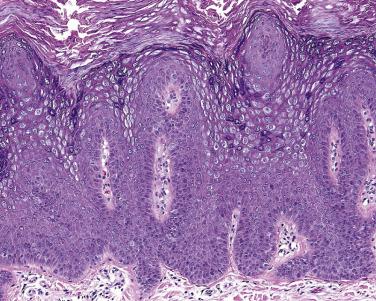
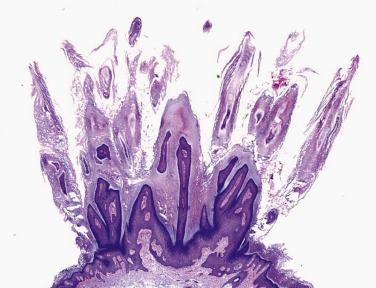
Other, less often biopsed, variants in the spectrum of verruca include verruca plana (plane or flat wart) and verruca palmaris or plantaris (myrmecia or palmoplantar wart). Clinically, the former is usually multiple, almost exclusively located on the face, neck, or extremities and, as the name implies, is flat to slightly papular. The latter is usually found on palms or soles of adolescents and is typically endophytic and painful. Histologically, plane warts are usually symmetric and slightly hyperplastic, but verrucous changes and parakeratosis are minimal. Koilocytosis or minimal cytologic pleomorphism may be the only diagnostic clue in some cases. Myrmecia, in contrast with other types of warts, are typically symmetric and endophytic ( Fig. 23.3 ). They commonly have a hyperplastic epidermis with marsupialized verrucous changes positioned upon a broad, keratinocytic base. Cytologically, the superficial keratinocytes contain large, intracytoplasmic, keratohyaline granules. The overlying keratin is usually irregular, parakeratotic, and has a mosaic pattern, in contrast with the homogeneous compact orthokeratosis of the normal plantar and palmar keratin. HPV and verrucous changes have also been identified in follicular cysts.
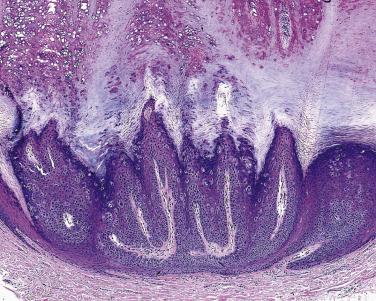
Condyloma is defined as a keratinocytic lesion that occurs on anogenital mucous membranes and is caused by one or more strains of HPV. These lesions are most commonly positive for the low-risk HPV subtypes, including strains 6, 11, 42, 43, and 44. Its verrucous form is a spectrum of lesions termed condyloma acuminatum, while the papular or flat form is termed condyloma planum .
Clinically, condyloma of any type can be found on persons of any age, but they are most often found in sexually active adults who have had multiple partners. The clinical lesions range from small (<5-mm papules) to, uncommonly, massive tumorlike lesions that may encompass the entire anogenital region. The differential diagnosis ranges from carcinoma in situ, to bowenoid papulosis, to seborrheic keratosis. Treatment must be individualized, but topical chemotherapy, surgery, dessication, or combinations have been met with varied success. Unfortunately, many of these lesions are recalcitrant to therapy.
Histologically, condylomata acuminata are hyperplastic, verrucous lesions in which the serpiginous epidermis is convergent and abuts the dermis across a broad front. Condylomata plana are acanthotic lesions without the verrucous changes. Both types typically have superficial koilocytosis ( Fig. 23.4 ), hypergranulosis, and homogeneous to convoluted nuclei that may be multiple. In many cases, cells in the lower layers have hyperchromatic nuclei that frequently are in mitosis. Some of these cases may be histologically similar to squamous carcinoma in situ, which should not be confused with the effects of podophyllin treatment. Condylomas have been associated with squamous carcinoma, which clearly suggests a continuum in this spectrum of lesions, especially in the context of bowenoid papulosis.
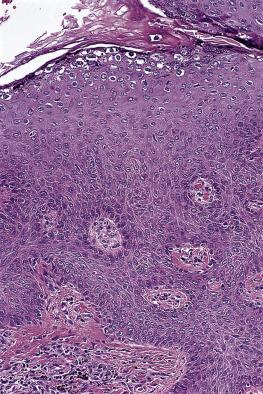
This rare condition is defined as disseminated flat or papular warts and macules that appear in the first years of life and persist throughout life. Often there is a positive family history. Additionally, malignancies such as squamous carcinoma in situ and squamous carcinoma may develop in the context of the lesions. Numerous HPV types, especially type 5, are often associated with epidermodysplasia verruciformis and may even be present in malignancies occurring in this setting. Presumably, other unknown immunologic factors are also involved in the pathogenesis of this disease. For example, it has been reported in association with organ transplantation and in the context of human immunodeficiency virus (HIV) infection.
Histologically, the flat warts of epidermodysplasia verruciformis are similar to conventional verruca plana, but some can have seborrheic keratosis-like changes. There may be slight verrucous hyperplasia with vacuolar cytoplasmic clearing toward the apex of the epidermis. This is accompanied typically by cellular enlargement. Nuclear pyknosis and both basket-weave orthokeratosis and parakeratosis may be observed. Ultrastructurally, intranuclear virus particles may be seen.
Changes of epidermodysplasia verruciformis (EV) have been noted in association with benign skin lesions, including intradermal nevi, pigmented seborrheic keratosis, and acantholytic acanthomas. EV-HPV has also been found in these lesions in the absence of clinical epidermodysplasia verruciformis. Epidermodysplasia verruciformis acanthoma is the name given when the EV changes are the primary histolopathologic finding in an isolated skin lesion.
One of the pox virus group, a DNA virus, is the causative agent for molluscum contagiosum. It is defined as a clinically papular, dome-shaped tumorlike condition, histologically characterized by so-called follicular molluscum bodies, or Henderson-Patterson bodies, which are spherical aggregates of viral particles.
Clinically it occurs in young persons or immunosuppressed patients, such as the HIV-infected population, who may have disseminated lesions that are recalcitrant to treatment. The lesions are usually 3 to 6 mm in diameter (rarely larger) and are umbilicated papules on an erythematous base. Pressure to the lesion results in the extrusion of white material, which represents collections of molluscum bodies admixed with keratin. Treatment is by local destruction, but molluscum may clinically be similar to basal cell carcinoma (BCC) in the appropriate context, and lesions may be biopsied as such.
Histologically it is characterized by a spectrum of cup-shaped to cystic lesions containing numerous diagnostic molluscum bodies, one per cell ( Fig. 23.5 ). From the deep follicular epithelium to the superficial portions, the molluscum bodies change from eosinophilic to basophilic. Accompanying this, there is associated compression of the individual nuclei and hypergranulosis. Eventually the body is extruded onto the surface along with keratin flakes. The histology is unique; no other differential diagnosis need be considered. Rarely, lesions of molluscum contagiosum may be associated with unusual hematologic infiltrates, some of which can be striking histologically, but are benign biologically.
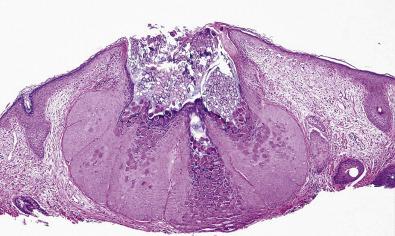
Some epidermal lesions present clinically as a solitary, tumorlike appearance and yet the histology shows an inflammatory, rather than a tumoral, condition. Lichenoid and psoriasiform keratosis are typical examples.
Benign lichenoid keratosis, also known as lichen planus–like keratosis, is a common, cutaneous entity that clinically can be confused with a cutaneous malignancy. Histopathologic variants include a classic flat type ( Fig. 23.6 ), bullous type, atypical type with cytologically atypical lymphocytes, an early or interface type, and a late regressed or atrophic type. Average age at presentation is 59.5 years with an age range of 36 to 87 years. The gender frequency is 76% female, 24% male. The trunk is the most common location (76%), followed by the extremities (33%) and head and neck (7%). Multiple lesions can be seen. Variable numbers of plasma cells, eosinophils, and neutrophils are identified as well as epidermal parakeratosis, distinguishing these lesions from typical lichen planus. Ocassionally, remains of a solar lentigo or large cell acanthoma can be seen, suggesting that the inflammatory infiltrate is directed to actinically damaged keratinocytes. The early interface type showed single lymphocytes aligned along the dermoepidermal junction without epidermal acanthosis or adjacent lentigo. The regressed or atrophic variant showed epidermal atrophy with papillary dermal scarring, patchy lymphocytic infiltrates, and melanin incontinence. If there are sufficient epidermal acanthosis or verrucous changes, these are likely to represent an inflamed wart or seborrheic keratosis.
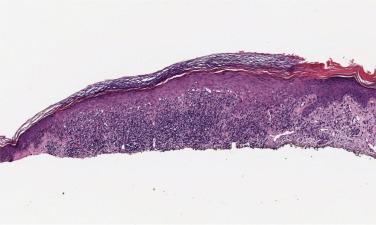
We have described, in a series of 18 cases, a keratosis that histologically mimics lesions of psoriasis but occurs as a solitary lesion in patients without clinical psoriasis. Lesions clinically present as a solitary erythematous scaly papule or plaque, most commonly on the upper or lower extremities. Adults, typically older than 50 years, are affected, and lesions occur in both genders. The most common clinical diagnoses are seborrheic keratosis, basal cell carcinoma, and forms of squamous cell carcinoma. Histologically, there is regular epidermal acanthosis with hyperkeratosis. Focal to confluent mounds of parakeratosis intercalated with collections of neutrophils are present in tiers throughout the cornified layer. Areas of hypogranulosis and hypergranulosis are present. Ectatic small blood vessels in the papillary dermis and a sparse superficial perivascular lymphocytic infiltrate are seen. Clinical correlation is necessary to exclude disseminated psoriasis in these patients. While the etiopathogenesis of these lesions is not clear, Sezer et al identified HPV type 6 in a psoriasiform keratosis and suggested it is possible this may be the etiologic factor in the pathogenesis of this disorder. We believe that psoriasiform keratoses should be classified in a group of cutaneous acanthomas that have a unilesional presentation but histologic features of classically widespread conditions, such as acantholytic acanthoma, lichenoid keratosis, and epidermolytic acanthoma.
Acantholytic acanthoma is defined as a keratinocytic proliferation in which the integrity of the keratinocytic attachments, the desmosomes, is diminished, resulting in acantholysis. Clinically, such lesions occur in adults of either sex and present as keratotic papules in the 1-cm size range. With some exceptions, they are typically located on the trunk. The clinical diagnoses range from basal cell carcinoma to solar keratosis to seborrheic keratosis. Patients lack a positive history of Grover disease (transient acantholytic dyskeratosis), Darier disease, or Hailey-Hailey disease (familial benign pemphigus).
Histologically, the lesions are characterized by a range of epithelial hyperplasia and acantholysis at some (but any) level(s) within the epidermis ( Fig. 23.7 ). Lesions can display subcorneal, intracorneal, suprabasal cleavage, or any mixture of cleavage points, and may mimic other acantholytic or bullous disorders. Acantholytic acanthomas, however, lack the monomorphous cytology and the keratin-filled microcavities of seborrheic keratosis.
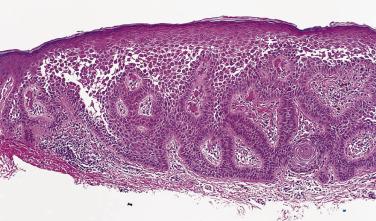
A type of acantholytic acanthoma is the warty dyskeratoma, which presents clinically as a verrucous, popular, or cystic lesion. Microscopically, it has a crater-shaped or cystic architecture ( Fig. 23.8 ). There is a papillary hyperkeratotic growth with associated acantholysis and the formation of villi ( Fig. 23.9 ). The acantholysis is usually suprabasal, but also can extend into the stratum malpighi. Abundant single cell dyskeratosis, as well as nucleated or anucleate (“corp rond” and “grain”) cells, are seen within the epidermis in a pattern similar to Darier disease. While most lesions have a verrucous architecture, others occur in a cystic follicular structure. These histologic changes may be indistinguishable from those seen in Darier disease, transient acantholytic dyskeratosis, and forms of linear epidermal nevus. The incidental finding of acantholytic dyskeratosis is very common in larger surgical specimens of re-excisions of melanomas and basal cell carcinomas. In the absence of a disseminated dermatosis or clinically evident lesion they have no clinical relevance.
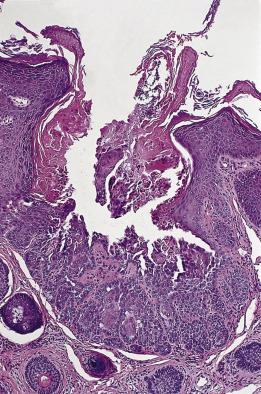
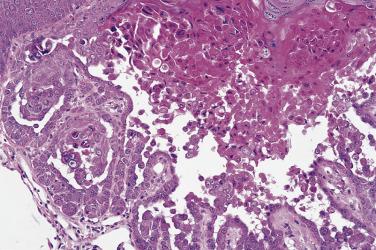
Epidermolytic acanthoma is defined as a discrete, idiopathic keratinocytic lesion with histologic changes of epidermolytic hyperkeratosis.
Lesions with histologic features of epidermolytic hyperkeratosis correspond to an entire spectrum of clinical changes. These can vary from isolated patches in any context (focal epidermolytic hyperkeratosis), to tumorlike lesions, to cysts, to palmoplantar hyperkeratosis, to epidermal nevi, to seborrheic keratosis, to congenital ichthyosiform erythroderma. The lesions occur in children or adults of either sex as solitary, multiple, or disseminated discrete lesions of the face, extremities, or anogenital regions. The differential diagnosis is with verruca, molluscum contagiosum, folliculitis, or soft fibroma.
Histologically the lesions are characterized by a spectrum of altered keratinocyte maturation, resulting in clear cells with indistinct nuclear borders, prominent keratohyaline granules in the spinous and granular layers, and a surface of irregular, compact orthokeratosis with a mosaic pattern ( Fig. 23.10 ). In addition, these histologic changes can be seen in a host of other lesions, such as seborrheic keratosis or squamous carcinoma. HPV has not been detected in these lesions, but it has been suggested that the pathogenetic mechanism may be mutations of the keratin K1 and K10 genes. Ultrastructurally, the essential changes are those of abnormal bundles of tonofilaments in the spinous layer, abnormally large keratohyaline granules in the lower granular layer, and pronounced intercellular edema. The main histologic differential diagnoses are with epidermolytic solar keratosis and palmoplantar verruca (myrmecia).
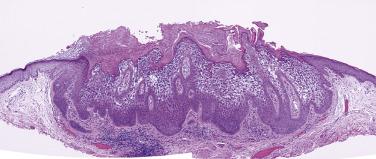
Some years ago, we described a solitary lesion with a distinct pattern of cornoid lamellation, which we termed porokeratoma . Lesions occur in adults, usually over 50 years, and are seen in both genders. The clinical description is a hyperkeratotic to verrucous solitary plaque or nodule distributed mainly on the distal upper and lower limbs. Histologically, these are sharply defined lesions characterized by acanthosis and verrucous hyperplasia with prominent multiple and confluent cornoid lamellae ( Fig. 23.11 ). In our series, patients did not have a personal or family history of porokeratosis or immunosuppression. We believe these lesions represent benign acanthomas with features of porokeratosis.
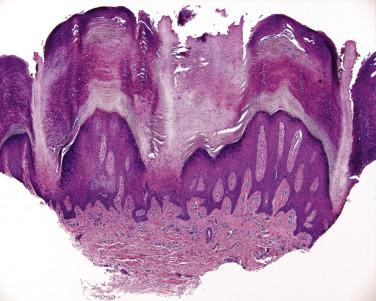
Granular parakeratotic acanthoma represents a benign solitary keratosis that histopathologically displays striking infundibulocentric granular parakeratosis. Like the dermatosis known as granular parakeratosis, these keratoses are found mostly on females. However, in contrast to the dermatosis granular parakeratosis, only two of the nine granular parakeratotic acanthomas were intertriginous; most of these lesions were located on nonintertriginous skin of the trunk. It is not known why these keratoses display foci of granular parakeratosis, but a granular parakeratotic diathesis is unlikely because none of the patients had evidence of granular parakeratosis (the dermatosis itself) elsewhere. Each of these keratoses displayed dense inflammation, and it is unclear whether this plays some role in the pathogenesis of these lesions. A striking feature of these lesions is the infundibulocentricity of the granular parakeratosis. It is not apparent why this occurs because infundibular epithelium and keratinization are identical to that of the epidermis. Perhaps this is related to unique features of the infundibulum itself (i.e., bacterial colonization and sebum). Overlying the thickened granular layer in foci at tips of epidermal proliferations are orthokeratotic mounds of large, dull, eosinophilic corneocytes that are sharply demarcated from the thickened granular layer. Basophilic keratohyalin (sic) granules are focally retained within these corneocytes.There is parakeratosis focally present in the stratum corneum.
Clinically, VX usually presents as an asymptomatic solitary verrucous, papillomatous papule or plaque with a color varying from reddish pink to gray and a diameter ranging from 0.2 to 2 cm. It may mimic a viral wart, condyloma accuminatum, verrucous carcinoma, or, less frequently, squamous cell carcinoma. Histopathologically, VX is characterized by strongly eosinophilic hyperkeratosis, columnar invaginated parakeratosis, verrucous acanthosis, and elongation of rete ridges. Numerous single and clustered neutrophils are present within the epidermis. Xanthomatous histiocytes are presently limited to the papillary dermis and do not extend below the tips of rete pegs ( Fig. 23.12 ). This finding can be subtle, and the peculiar keratinization and neutrophils should induce a careful search for the foamy cell papillary dermal component.
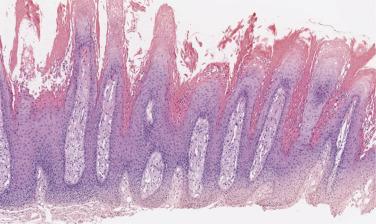
Clear cell acanthoma is defined as a discrete idiopathic, psoriasiform lesion of large, pale-staining, nonkeratinizing, glycogenated, monomorphous keratinocytes associated with neutrophils. The lesion is sharply separated from the adjacent epidermis as well as any included adnexal elements.
Clinically, this asymptomatic lesion is usually discovered after months to years. It almost always occurs in adults, affects either sex equally, and is most commonly located on the lower limbs but can also be found on the trunk and face. It is usually solitary but can be multiple and/or eruptive. Individual lesions are papular to polypoid, and skin colored red to brown, depending on the amount of vascularization. The size range is usually 1 to 2 cm; rarely, it is larger. Close inspection may highlight pinpoint capillaries that blanch with the application of pressure; however, clinical bleeding is rare, in contrast with an acrospiroma. The surface is typically smooth to bosselated, moist and glistening, but may be surfaced by a fine, waferlike scale in some cases. Local excision or destruction is usually curative, but rare lesions have recurred. The clinical differential diagnosis is with lobular capillary hemangioma (pyogenic granuloma), ulcerated exophytic basal cell carcinoma, exophytic fibrous histiocytoma, and smooth seborrheic keratosis. Other lesions, such as polypoid malignant melanoma, have rarely been included in the differential diagnosis.
Histologically, it is usually symmetric and variably elevated in comparison to surrounding skin, but its base is commonly situated below the rete ridges of the adjacent normal epidermis ( Fig. 23.13 ). The lesional rete ridges are broad based to psoriasiform to reticulated; often, they are centripetal, but there is considerable variation from case to case, including a rare cystic pattern. The surface is orthokeratotic and focally parakeratotic, although the granular layer is diminished or absent. Characteristically, a sharp line can be drawn between the lesional cells and the adjacent normal epidermis. In addition, any adnexal structure contained within the lesion is separated by a sharp dividing line, usually a few cells thick. Cytologically, the epithelial cells within the lesion are monomorphous and contain abundant, palely eosinophilic cytoplasm ( Fig. 23.14 ); often there is slight intercellular edema. There are few to no cells in mitosis in most cases; rare cases with mitoses probably represent clear cell squamous carcinomas showing morphologic overlap with clear cell acanthoma. PAS stain, with and without diastase, reveals abundant cytoplasmic glycogen in the lesional cells. In contrast with sweat glands, clear cell acanthomas are negative for phosphorylases. Melanocytes within the lesion are variable in number and usually are the only cell type containing any melanin granules. Exceptionally, melanization is observed within keratinocytes. Immunoperoxidase staining with cytokeratins and involucrin, as well as the patterns of numerous lectins, supports surface differentiation. Ultrastructurally, the chief features are abundant intracytoplasmic glycogen and lysosome-like granules. A curious feature seen in most lesions is the accumulation of neutrophils within the lesional epidermis. The neutrophils can either be intact or fragmented and either single or in clusters. They are usually present at all levels of the epidermis, unlike the spongiform pustules of psoriasis.
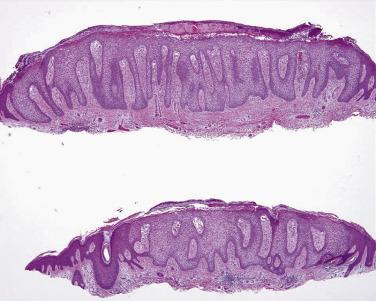
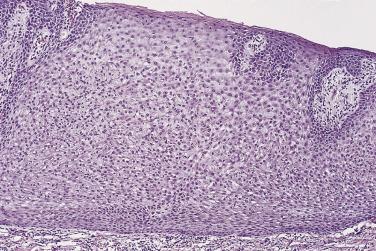
The papillary dermis typically is edematous; the papillary dermal capillaries are usually prominent and, at times, tortuous. A mononuclear infiltrate of lymphocytes, plasma cells, or both, is usually present. Rarely, eosinophils may also be present. Sweat duct hyperplasia under the lesion may or may not be observed. One reported case was associated with an eccrine syringofibroadenoma.
The histologic differential diagnosis is with intraepidermal acrospiroma, tricholemmoma, tumor of the follicular infundibulum, seborrheic kerarosis, and psoriasis. Sometimes the classic histologic changes of clear cell acanthoma are not associated with a distinct tumor, but they are probably a reaction pattern.
Seborrheic keratosis is defined as a benign epidermal proliferation composed principally of monomorphous basaloid keratinocytes and characterized by several growth patterns.
Clinically, the lesions are usually multiple and most commonly arise in middle-aged adults of either sex. Typically, they occur on the trunk, head and neck, and, less commonly, on the genitals. They almost never occur on the palms or soles. They are soft to hard, depending on the amount of keratinization, and they have a greasy, stuck-on appearance when they are exophytic. The color ranges from fleshy to yellow to black. Lesions in the seborrheic keratosis spectrum can be cured by simple excision, curettage, or cryotherapy. The clinical diagnosis is usually straightforward; however, some may be confused with malignant melanoma if they are deeply pigmented or display areas of inflammation and regression.
Histologically, the tumors are usually symmetric at the level of the adjacent epidermis. They are typically elevated, resulting in an exophytic expansion ( Fig. 23.15 ). The spectrum of architectural patterns includes acanthotic, hyperkeratotic, reticular, and verrucous forms. Within these general architectural patterns there are a number of growth patterns, which can be uniform or mixed in any individual lesion. These include monomorphous, pleomorphic, clonal, fascicular, and acantholytic. Typically there are horn and pseudohorn cysts, which are orthokeratotic microcavities either within the substance of the thicker lesions (horn cysts) or have communications to the surface (pseudohorn cysts). Any particular lesion, especially if thin, may be devoid of these. Such cavities can be isolated cysts or tubular cuniculi in three-dimensional reconstructions. These microcavities are believed to be derivatives of the folliculosebaceous units adjacent to or below the lesion.
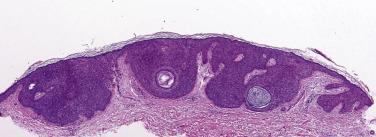
Seborrheic keratoses can sometimes also be associated with neoplasms, including basal cell carcinoma, Bowen disease, tricholemmoma, keratoacanthoma, nevi, and even malignant melanoma. The incidence of associated nonmelanoma cancers was 4.6% in one study of 100 excised seborrheic keratoses. This fact underscores the importance of histologic examination of clinically unusual seborrheic keratoses. Seborrheic keratosis-like epidermal proliferations are often associated with melanocytic nevi and dermatofibromas.
We distinguish between irritated and inflamed seborrheic keratoses. Inflamed seborrheic keratoses contain an abundant inflammatory infiltrate with lichenoid qualities. These can have any of the abovementioned growth patterns; in addition, however, there is an inflammatory infiltrate composed typically of mononuclear cells, melanophages, or both ( Fig. 23.16 ). In some extreme cases, the entire seborrheic keratosis undergoes regression, evidenced by remnants of the original lesion and a clinical history of a lesion that changed.
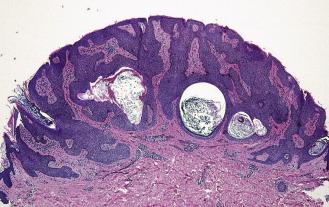
Irritated seborrheic keratoses are produced by trauma, often picking by the patient. Irritated seborrheic keratoses can contain horn and pseudohorn cysts with a range of keratinization patterns, from fully orthokeratotic to mixed to fully parakeratotic. Acantholysis in the midst of the lesion is relatively common in these lesions. These areas contain mucin, in contrast with the suprabasal acantholysis of actinic keratoses and squamous cell carcinomas. Squamous eddies are present, and mitoses can be numerous. These lesions can, at times, be very difficult to distinguish from well-differentiated squamous cell carcinomas, particularly in shallow shave biopsies.
Cytologically, the tumor cells in any of the forms of seborrheic keratosis are uniform, basaloid, connected by readily observable intercellular bridges, and surfaced by orthokeratotic keratin, unless they are secondarily traumatized. Individual keratinocyte maturation is present in some lesions and is characterized by greater cytoplasmic eosinophilia, keratinization, apoptosis, or all these features. In some lesions, these mature keratinocytes are closely and stereotypically apposed to form nested patterns or eddies, often seen in the irritated forms. Some seborrheic keratoses contain fusiform or stellate keratinocytes that often are oriented in fascicular arrays within the lesion (swarming). This feature is seen commonly in the irritated forms. In the clonal seborrheic keratoses, spherical groups of keratinocytes have a monomorphous appearance separated by trabeculae of keratinocytes with slightly pleomorphic cytology. Acantholytic forms contain keratinocytes with disintegrated desmosomes and basophilic mucin. Melanotic seborrheic keratoses contain numerous basaloid, pigmented keratinocytes. In other lesions, the pleomorphic seborrheic keratoses, a considerable number of keratinocytes in mitosis are detected, the significance of which is not fully known; however, we speculate that this attribute can be part of irritated lesions.
The main differential diagnoses include verruca vulgaris, inverted follicular keratosis (which is considered to be a variant of seborrheic keratosis), epidermolytic acanthoma, pale cell acanthoma, large cell acanthoma, verruciform xanthoma, some tricholemmomas, some lesions in the acrospiroma (poroma) group, and well-differentiated squamous cell carcinoma, especially in irritated lesions.
This is defined as a benign, usually symmetric, invaginated (inverted) proliferation of mature squamous cells that may be exophytic or endophytic. It is characterized histologically by the presence of prominent, stereotyped, closely apposed, concentric, laminated whorls of squamous cells with centripetal maturation, the so-called squamous eddies. There is debate regarding the validity of the concept, but we view it as a variant of seborrheic keratosis.
Clinically, inverted follicular keratosis is usually a solitary lesion less than 1 cm in diameter, typically affecting white middle-aged persons of either sex. It is a lesion that almost always occurs on hairy skin. It arises most commonly on the face, including the eyelids and the lip, but it can also be found on the extremities or trunk. The lesion can vary from smooth and papular to verrucous, from skin colored to pigmented, and from orthokeratotic to hyperkeratotic. Biologically, it is benign but rarely may recur if incompletely excised. The clinical differential diagnosis includes lesions such as verruca vulgaris, seborrheic keratosis, and a variety of other papules or keratoses.
Histologically, inverted follicular keratosis has two essential features: vertically oriented inverted architectural pattern and squamous eddies. Inverted, in this context, means deep growth into the dermis regardless of whether the entire lesion is exophytic or endophytic ( Fig. 23.17 ). There is often hyperkeratosis, which may be orthokeratotic, parakeratotic, or mixed. Extending from the surface are narrow to broad, vertically oriented to convergent cords of squamous cells that are blunt at their deepest extent. Most cases have no hair follicles beneath or within the lesion. Rarely, however, hair follicles traverse the lesion and exit onto the surface; in other instances, they end within the substance of the lesion. The squamous eddies are targetoid structures that can occur within any area of the lesion, but they are most prominent in the deeper portion. If keratinization is present, it is usually focal to minimal, much less than the typical keratin-filled microcavity or horn cyst of a seborrheic keratosis or the parakeratotic microcavity (“pearl”) of squamous carcinoma. Occasionally, sebaceous cells are closely apposed to squamous eddies, which suggests similarity to sebaceous ducts. Between the squamous eddies, the lesional cells are characterized by rounded and basaloid to fusiform cytology, often with frequent mitoses. Melanin pigment is observed in the keratinocytes of some lesions. The periodic acid-Schiff (PAS) reaction is positive in the keratinocytes in some cases. Thus far, only rare cases that have been studied with antibody to the common HPV antigen have been positive ; most have been negative. The stroma is typically fibrous and lacks the mucinous, induced quality of basal cell carcinoma stroma. A mononuclear cell infiltrate can be seen in the stroma, sometimes including eosinophils. The differential diagnosis is with seborrheic keratosis, tricholemmoma, squamous cell carcinoma, keratoacanthoma, verruca vulgaris, and (occasionally) infundibular tumors.
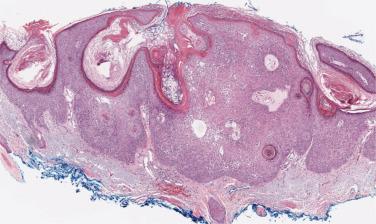
This benign reaction pattern may best be defined as epithelial hyperplasia with pronounced squamatization of the epidermis and adnexal epithelium (follicular, ductal, or both) resulting in a tumorlike condition resembling the infiltrative pattern of squamous cell carcinoma. When the duct involvement far overrides the follicular involvement, it is often termed squamous syringometaplasia or syringosquamous metaplasia .
Pseudocarcinomatous hyperplasia is not a clinical condition per se but results from a variety of clinical contexts in which there is skin trauma ( Table 23.1 ). These include postsurgical trauma, prurigo nodularis, chondrodermatitis nodularis helicis, and acanthoma fissuratum, among many others. In addition, pseudocarcinomatous hyperplasia can also be seen as a response to underlying lesions, such as granular cell tumor, Spitz nevus, solitary circumscribed neuroma, and deep fungal infections, including chromomycosis, sporotrichosis, blastomycosis, and halogenoderma.
| Criterion | Pseudocarcinomatous Hyperplasia | Squamous Carcinoma |
|---|---|---|
| Growth rate | Variable, often posttraumatic or postsurgical | Slow growth (months to years) |
| Symmetry | Usually symmetric | Asymmetric and slightly raised or ulcerated |
| Keratin plug centrally | Usually not, sometimes eroded | Rare |
| Transition zone | Abrupt transition between the lesion and adjacent epidermis | Gradual transition of normal epidermis to squamous cell pleomorphism to tumor |
| Border | Infiltrative | Variable, sharp or infiltrative, or both |
| Microcysts | When present, orthokeratotic, rarely parakeratotic | When present, usually parakeratotic |
| Adnexal involvement | Characteristic of the lesion, either follicular or ductal, or both | May or may not be present |
| Cytologic pleomorphism | Rare | Common |
| Cytoplasm | Abundant, often glassy or hyalinized | Abundant or minimal |
| Apoptotic keratinocytes | Uncommon | Common |
| Inflammatory infiltrate | Variable, but usually minimal | Variable |
| Perineural invasion | Rare | Uncommon |
| Subcutaneous involvement | Never | Not uncommon in large tumors |
| Fibrosis | When present, located adjacent to or within the lesion | When present, surrounds tumor nests |
| Resolution | Slow | None, without therapeutic intervention |
| Metastasis | Never | Rare, but may occur if deeply invasive |
Histologically, pseudocarcinomatous hyperplasia is usually symmetric and has a range of growth patterns from mostly uniform hyperplastic infundibular structures, to both infundibular and insular terminal duct squamatization, to insular duct squamatization alone ( Fig. 23.18 ). The border is usually confined but infiltrative. Microcysts, when present, can be filled with orthokeratotic, parakeratotic, or both types of keratin; however, orthokeratotic keratin is more common. The subcutis is not involved in such lesions unless there is a deep sinus track. There is minimal to no cytologic pleomorphism in pseudocarcinomatous hyperplasia; however, apoptotic keratinocytes may be seen in some cases.
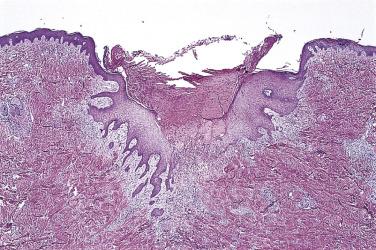
By contrast, squamous cell carcinoma typically has cytologic pleomorphism that involves both the surface and the infiltrative portions of the lesion; and parakeratotic microcysts are usually numerous. In addition, squamous carcinoma, unless small, is typically asymmetric. While the overwhelming majority of squamous lesions with perineurial involvement represent examples of squamous carcinoma, on occasion such changes can be seen in biopsy sites unassociated with a tumor. Thus it would seem reasonable that the lesion's architectural features should be given a high priority in the diagnosis of pseudocarcinomatous hyperplasia. For practical reasons these lesions are identified as squamous proliferative lesions. These lesions represent part of the spectrum of squamous proliferations that exhibit little or no cytologicl pleomorphism.
Keratoacanthoma denotes a spectrum of benign, cup-shaped tumors of keratinocytes that develop rapidly and undergo spontaneous regression. It is in the differential diagnosis with squamous carcinoma, to which it is compared in Table 23.2 . It is similar morphologically to some squamous carcinomas. There are differing opinions on the nature of keratoacanthomas; some authors reject the diagnosis altogether, while others (including us) embrace the diagnosis as one that must be used with caution but, nevertheless, must be used in the appropriate clinical and histologic context.
| Criterion | Keratoacanthoma | Squamous Carcinoma |
|---|---|---|
| Growth rate | Rapid growth (weeks to months) | Slow growth (months to years) |
| Resolution | Spontaneous | None, without therapeutic intervention |
| Symmetry | Symmetric dome with overhanging lips, vertical gradient | Asymmetric and slightly raised or ulcerated |
| Keratin plug | Central, common | Rare |
| Growth pattern | Exophytic and endophytic with central horn-filled crater | Endophytic with no crater |
| Transition zone | Abrupt transition between tumor and epidermis | Gradual transition of normal epidermis epidermal pleomorphism to tumor |
| Actinic keratosis | May be present but not contiguous | Present and contiguous |
| Subcutaneous involvement | Not common, but may be present in large tumors | Not uncommon in large tumors |
| Fibrosis | Dense, bandlike, located deep to the lesion | When present, surrounds tumor nests |
| Cytologic pleomorphism | Variable, some are very pleomorphic | More common, diffuse |
| Cytoplasm | Abundant, often glassy or eosinophilic | Irregular, abundant or scant |
| Acantholysis | Not seen | Frequent |
| Intraepithelial neutrophilic abscesses | Common | Rare |
| Keratinization patterns | Orthokeratotic with frequent granular layer | Usually parakeratotic, acantholysis |
| Intraepithelial elastic tissue | Common in peripheral tumor nests | Uncommon |
| Elastophagocytosis | Common | Rare |
| Inflammatory infiltrate | Common, dense and lichenoid | Variable |
| Eosinophils | Common and abundant | Rare |
| Plasma cells | Rare | Common and abundant |
| Langerhans cells | Increased (especially in inflamed variety) | No increased amount |
| Melanocytes | Absent | Present |
| Lymph node involvement | Absent | Present |
| Perineural invasion | Rare, but present in deeper tumors | Rare |
| Adenomatoid sweat duct hyperplasia | Common | Rare |
Clinically, keratoacanthomas are symmetric lesions that usually develop on sun-exposed skin of elderly or immunosuppressed persons of either sex. They typically are exophytic and contain a central plug of keratin. Less common variants include those that occur on sun-protected skin, giant forms (keratoacanthoma marginatum centrifugum), multiple and syndromic forms, and subungual keratoacanthoma. Keratoacanthomas can be treated with excision or close clinical follow-up after establishment of the histologic diagnosis.
Histologically, keratoacanthomas are symmetric lesions with deep bulbous lobules of squamous cells containing abundant eosinophilic, translucent cytoplasm, which is typically termed glassy . At the periphery there is a lip of normal epidermis that extends over the central keratinous crater ( Fig. 23.19 ). Keratin is usually abundant over the keratinous lobules. Apoptotic keratinocytes are usually present in the lobules ( Fig. 23.20 ). Keratin may be observed in microcavities; when this occurs, it is usually parakeratotic and is often associated with microabscesses ( Fig. 23.21 ), as well as with entrapment of elastic and collagen fibers. The infiltrate around the periphery of the lesion is usually lymphocytic and eosinophilic; plasma cells are found only rarely. Zones of perineurial involvement may be observed and are not particularly helpful in differentiating keratoacanthoma from squamous cell carcinoma. Vascular involvement may occur rarely but is not necessarily associated with adverse outcome. In unusual cases, lesions in the histologic spectrum typical of keratoacanthoma will pursue an aggressive clinical course, suggesting that the initial lesion was diagnosed incorrectly or that the differentiation from some squamous carcinomas is not always possible by conventional microscopy and clinicopathologic correlation. The opposite may also happen, and it is known as abortive keratoacanthoma, characterized by rapid growth and subsequent lichenoid regression at an early stage in the evolution. Lichenoid changes extend for a variable distance beyond the lesion. Weedon et al felt that lichenoid regression, rather than terminal differentiation, is the main mechanism of its involution.
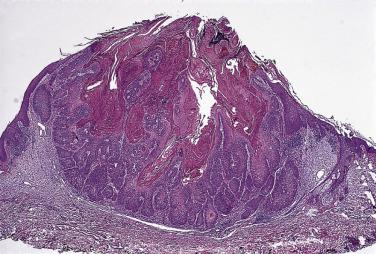
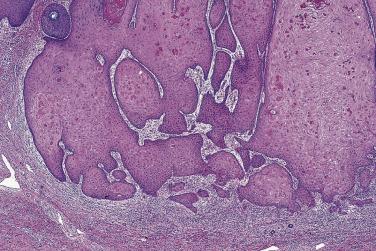
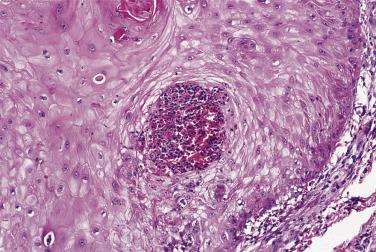
Cytologically, the keratinocytes vary from bland and uniform to pleomorphic with numerous mitotic figures, but none of these features will help determine the diagnosis with certainty. Architectural features are more helpful than cytologic features in establishing the diagnosis.
There have been attempts to find a way to differentiate keratoacanthoma from squamous cell carcinoma by using modern techniques (other than clinicopathologic correlation), and these attempts have not met with great success. For instance, there have been attempts to show that the expression of p53 might differentiate the two. However, even controls, such as pseudocarcinomatous hyperplasia, express p53, and it appears that the expression of p53 protein, mutant or wild type, is an indicator of immaturity and proliferative capacity of the cell rather than one of neoplasia or malignancy. The expression of bcl2 activity, a proto-oncogene recognized to be involved in protecting cells from undergoing apoptosis, is diminished in keratoacanthomas when contrasted with squamous carcinomas, suggesting that keratoacanthoma, for unknown reasons, is programmed to involute, but one would hardly base a diagnosis on this parameter alone. The proliferation antigen, Ki67, is likewise expressed in both types of lesions and will not serve to differentiate them. Other methods, such as immunohistochemical demonstration of desmosomal glycoproteins, may be a useful adjunct but are not definitive.
We continue to believe that keratoacanthoma is a useful diagnosis and, if made in the proper clinical context, is a service to the patient and the clinician treating the patient. The distinction between keratoacanthoma and squamous cell carcinoma can be made with confidence, particularly if the pathologist is provided with an adequate biopsy.
The development of squamous cell carcinoma in a keratoacanthoma alluded to by Rook and Whimster in 1979 and by Reed in 1993 was confirmed by Sánchez Yus et al in 2000. Weedon et al found this phenomenon in 5.7% of keratoacanthomas in a series of 3465 cases. Its incidence in patients older than 90 years was 13.9%. The incidence of perineural invasion in this series of keratoacanthomas was 0.2%.
The actinic keratoses are a spectrum of keratinocytic lesions confined to the epidermis with variable cytologic morphologies that occur secondary to prolonged exposure of the skin to ultraviolet rays ( Box 23.2 ). These include lesions that are associated with, but are not necessarily limited to, solar radiation. The variants are relatively limited, of which only lentigo senilis, large cell acanthoma, and actinic keratosis are discussed in depth here. Lichenoid keratosis is included in the discussion of actinic keratosis. Disseminated superficial actinic porokeratosis is beyond the scope of this chapter but is discussed elsewhere. In this discussion, the position is taken that the conventional actinic (solar) keratosis is a form of carcinoma in situ, but whether all types of actinic keratosis should be included as carcinoma in situ remains to be determined.
Solar lentigo (lentigo senilis)
Lichenoid (actinic) keratosis
Large cell acanthoma
Disseminated superficial actinic porokeratosis
Actinic keratosis spectrum (patterns and cytology may be mixed)
By thickness
Atrophic (hypoplastic)
Orthotrophic (euplastic)
Hypertrophic (hyperplastic)
By growth pattern
No rete ridges
Budded, filiform to broad-based
Verrucous
Adenoid
Pagetoid
By cytology
Minimal or basilar pleomorphism
Pleomorphism with maturation
Bowenoid with or without extensive keratinization
With or without pigmentation
Clear cell
These are pigmented, macular to velvety pigmented lesions composed of keratinocytes rather than being melanocytic in nature. Melanin hyperpigmentation is present at the basal layer. Although there are distinct lesions, there is considerable overlap. It is common to see lesions that have smooth transitions from one pattern to the other. They also have a unique dual separate terminal differentiation path. While some may acquire increasing cellular pleomorphism and may evolve into actinic keratoses, usually pigmented, others evolve into seborrheic keratoses.
This is clinically an irregularly circumscribed, pigmented macule or thin plaque on sun-exposed skin. Histologically, it is characterized by periodic, elongated, hyperpigmented rete ridges associated with some (but any amount of) dermal solar elastosis. The melanocytic hyperplasia is not obvious by hematoxylin and eosin (H&E) stain.
Clinically, the lesions are typically multiple and arise on the face and arms of middle age to older adults with fair skin. The macules are discrete or coalescent, usually 1 cm or less, and pigmented to some degree; often they are black. They are benign and no special treatment is required. The clinical differential diagnosis ranges from lentigo simplex to lentigo maligna to thin seborrheic or solar keratosis.
Histologically, the lesions are well demarcated and uniform throughout. There is periodic elongation and hyperpigmentation of the rete ridges, which have a club-shaped pattern ( Fig. 23.22 ). Parakeratosis is usually absent. Most of the pigmented cells are keratinocytic; however, there may be a slight absolute increase in melanocytes, which may require special techniques to quantify, in contrast with an ephelis or lentigo simplex. Cytologically, the hyperpigmented keratinocytes are usually of uniform size and are not in mitosis. Some forms of solar lentigo have an acanthotic epidermis without the clubbing. An acanthotic form is also seen in which the thin club appearence is replaced by a thicker acanthotic lesion with rounded, undulating rete pattern. These lesions sometimes have overlapping features with large cell acanthoma. In fact, it is common to see complex lesions with features of solar lentigo, large cell acanthoma, and incipient seborrheic keratosis in the same field.
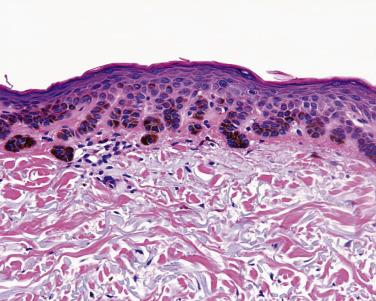
The only significant histologic differential diagnoses are with mucosal melanotic macule, ephelis, and lentigo simplex, although the changes of solar lentigo may be seen in association with other lesions, such as lichenoid keratosis and reticulated seborrheic keratosis.
This is defined as a plaque occurring on sun-exposed skin in which the histologic hallmark is large, sharply demarcated, relatively uniform keratinocytes that are polyploid, which exhibit hypergranulotic-orthokeratotic maturation, and in which there is usually sparing of the cells of the acrotrichium, acrosyringium, or both, which may traverse the lesion. Some lesions within the spectrum are similar to seborrheic keratoses, while others have features of carcinoma in situ.
Clinically, large cell acanthoma is more commonly found on women. It ranges from a pigmented yellow to brown or (rarely) achromic, symmetric plaque with a slight keratin scale. It usually measures 0.5 to 1 cm in diameter and is most commonly located on the face, but may also occur on the limbs or trunk. Uncommonly, it can be multiple. It is biologically indolent, may be present for decades before diagnosis, and can be treated with locally destructive methods. The clinical differential diagnosis is with solar lentigo, seborrheic keratosis, solar keratosis, and basal cell carcinoma.
Histologically there is a sharp transition from the surrounding normal epidermis to the lesion ( Fig. 23.23 ). At scanning magnification, the epidermis is normal to slightly thickened, to verrucous ; it is symmetric and often exhibits hyperpigmentation of the basal cells. The rete ridges are altered, ranging from absent to uniform, often with a square-wave or club-shaped pattern in approximately half the cases. The keratinocytes display maturation through a zone of hypergranulosis, which may range from minimal to marked. The surface shows basket-weave orthokeratosis when the hypergranulosis is minimal and laminated orthokeratosis, similar to some seborrheic keratoses, when the hypergranulosis is marked. In extreme cases, the keratin develops a mosaic pattern, similar to plantar warts. Glycogen is usually present in the keratinocytes in the upper half of the lesion. There is no increase in the number of basilar melanocytes, in contrast with lentigo simplex.
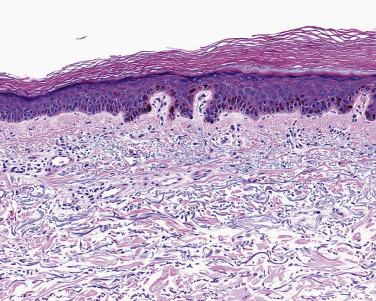
Cytologically, the typical basal cell of the lesion is approximately twice the size of a normal basal cell; often, its nucleus is apically oriented with abundant cytoplasm adjacent to the basement membrane. Melanin granules may form a cap over the basal cell nucleus. Any adnexal structures within the lesion are usually lined by normal-size cells, which often is useful for comparison, but there are exceptions to this observation. Mitotic figures or apoptotic cells are uncommon, but in some cases they may exist above the basal layer, raising the question of carcinoma in situ. The dermis usually has some degree of solar elastosis, telangiectasia, chronic inflammation, or a mixture of all of these features. The differential diagnosis is with solar lentigo and solar keratosis, patterns of which may coexist in any particular lesion. Some lesions are difficult to differentiate from a carcinoma in situ. This fact raises the issue if these lesions are related or large cell acanthoma represents an early transitional form. Large cell acanthomas are not associated with dermal invasion.
Actinic (solar) keratosis is defined as a lesion of pleomorphic keratinocytes that exist in one or more layers of the epidermis, which may be present as irregular budlike extensions in the papillary dermis, and which do not extend into the reticular dermis. The analogous lesion in the vermillion of the lip is termed actinic cheilitis .
While the prevalence of these lesions is not known with certainty, most patients are fair complexioned, middle aged or elderly, and have multiple lesions that are erythematous, circumscribed, scaly patches or cutaneous horns on sun-exposed areas. Hypertrophic lesions are found commonly on the hands. Uncommon clinical presentations, such as the spreading pigmented form, often found on the face, may be confused with lentigo maligna or seborrheic keratosis. With some exceptions, such as those documented cases in which a recurrent lesion has been associated with the later development of squamous carcinoma, solar keratosis is a biologically indolent or a slowly progressive lesion that can be treated effectively with procedures such as cryotherapy or chemotherapy. The biologic evidence is undeniable that actinic keratoses are fully capable of developing into squamous carcinoma if left untreated and, in this context, it is a type of squamous carcinoma in situ.
The histologic variation of lesions included within this spectrum is wide, and multiple histologic patterns often coexist within an individual lesion. They range from atrophic ( Fig. 23.24 ) to hypertrophic (hyperplastic) ( Fig. 23.25 ). There may be a single layer of pleomorphic keratinocytes to full-thickness (bowenoid) pleomorphism ( Fig. 23.26 ). The growth patterns can vary from homogeneous, to heterogeneous and epidermolytic, to pagetoid, to acantholytic (Darier-like; pseudoglandular). Typical cases are characterized by disorganized patterns of keratinocytic maturation, loss of the granular layer, and budlike extensions into the papillary dermis.
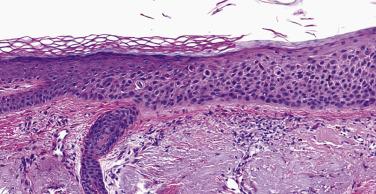
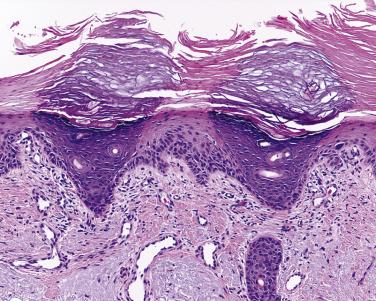
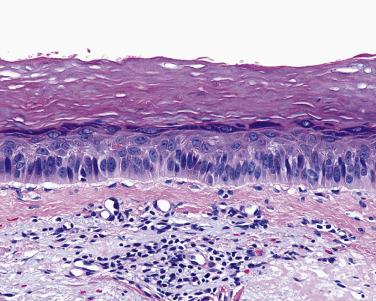
A classic histologic feature of actinic keratosis on H&E, when present, is the sparing of the cutaneous adnexa. The usual basal cell pattern is replaced by enlarged or pleomorphic squamous cells that are interrupted only by the entrance of the follicles or ducts. The overlying parakeratotic surface keratin reflects the abnormal maturation of the keratinocytes; however, the adnexal keratinocytes and keratin are spared, with the exception of peripheral cuffs of enlarged or pleomorphic keratinocytes in some cases. This results in thin, vertical columns of adnexal orthokeratin alternating with the broad, parakeratotic surface keratin. Frequently, depending on the density of adnexa and the amount of keratin produced by the lesion, the parakeratotic tiers may also be narrow and columnar.
Cytologically, the range of keratinocytic variation is from monomorphic to pleomorphic, eosinophilic to clear cell, and pigmented to nonpigmented types. Many keratinocytes have abundant eosinophilic cytoplasm; some can be multinucleate. Others are apoptotic. When the lesions are pigmented, melanin is found in keratinocytes and melanophages.
The inflammatory dermal infiltrate under an actinic keratosis ranges from almost none to extensive. It is usually mononuclear, but eosinophils and neutrophils are seen occasionally, especially when the lesion is secondarily excoriated or perforated. Some authors have used the term lichenoid actinic keratosis to denote a solitary lesion that bears a strong resemblance to lichen planus, but has parakeratosis of the stratum corneum and a modest range of keratinocytic enlargement or pleomorphism. Others doubt the validity of such a concept and designate these lesions simply as benign lichenoid keratoses or, simply, lichenoid keratosis, which they classify in the benign keratinocytic proliferations. We have found that the latter designation is practical and correlates well clinically.
Actinic keratosis of some anatomic sites have rather characteristic features. Actinic keratoses of the scalp are usually heavily inflamed and associated with a thick inflammatory scale that sometimes obscures the diagnostic features of the lesion. Actinic keratoses of the dorsum of the arms and hands are very deceptive histologically. The lesion lacks cellular pleomorphism, and it is is made up of homogeneous, pale-staining keratinocytes. The diagnosis can be made by contrasting the periphery of the lesion with normal epidermis. There is a sharp interface demonstrating the clear separation between both areas, and the abnormal keratinization of the actinic keratoses becomes more evident.
We use the term Bowen disease to denote a type of squamous cell carcinoma in situ that exists as a spectrum of lesions that are similar to squamous cell carcinomas often involving the full thickness of the epidermis but without an invasive component.
While these lesions have a relatively low incidence of developing cutaneous invasive carcinoma, the opposite occurs in lesions localized on mucosal sites, such as the glans penis or vulva. Thus we view the concept of squamous cell carcinoma in situ as useful as long as it is viewed in the proper context.
On the basis of our definition there are several distinctive clinical contexts that require separation. The most characteristic class of lesions is those comprising Bowen disease, a term that is often used interchangeably with squamous cell carcinoma in situ. Bowen disease designates a clinical presentation of large erythematous plaques usually occurring on the trunk. When similar lesions occur on the vulva, glans penis, or oral cavity, the term erythroplasia has been applied. Some chemical agents, such as arsenicals, have also been associated with the development of cutaneous lesions. When lesions with similar histology occur on sun-exposed sites, the term bowenoid actinic (solar) keratosis was once in vogue. This term is not without peril, since dermatologists treat these two lesions in different ways. When the diagnosis of Bowen disease is made, the treatment is usually full excision of the lesion; if it is termed bowenoid actinic keratosis, however, they tend to use less aggressive treatments. While useful and conceptually correct, because of the treatment differences and reluctance of dermatologists to accept the term, we do not use the term bowenoid actinic keratosis . Lesions that occur as discrete pigmented papules on the anogenital region of young persons have been termed bowenoid papulosis (see upcoming discussion). The latter are usually associated with high-risk subtypes of HPV, and they uncommonly progress to carcinoma.
Histologically, the spectrum of squamous cell carcinoma in situ is wide. The scanning magnification pattern may be flat to verrucous and from atrophic to hyperplastic. All lesions have full thickness squamous cell abnormalities in maturation ( Fig. 23.27 ). Some lesions have nested (clonal) patterns ( Fig. 23.28 ); others have clear cell changes ( Fig. 23.29 ), and some patterns may be similar to Paget disease or classic intraepidermal patterns of melanoma ( Fig. 23.30 ). The acrotrichium and follicular infundibulum are involved in many cases by vertically oriented extension of carcinoma in situ. Sometimes this process completely replaces the pilosebaceous unit.
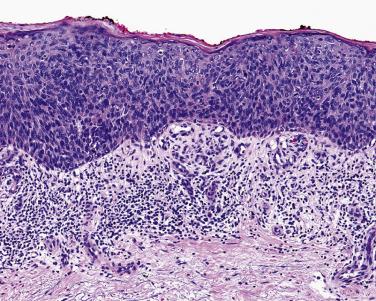
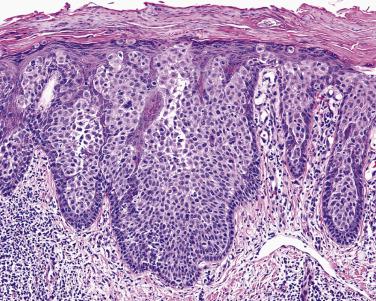
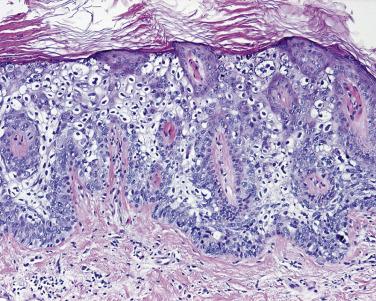
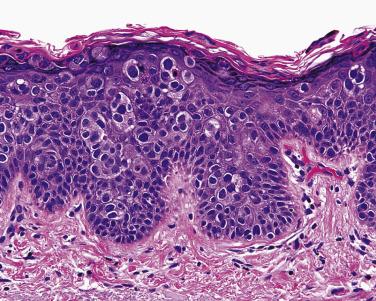
There is usually a high degree of pleomorphism of keratinocytes in squamous cell carcinoma in situ. Numerous cells in mitosis or apoptosis are observed typically. Unusual cases, however, show uniform cytology without maturation as one observes the lesion from deep to superficial. Lesions occurring in dark-skinned individuals may be pigmented irregularly throughout, sometimes by dendritic melanocytes. The stratum corneum is usually characterized by confluent parakeratosis, but bowenoid actinic keratoses are often surfaced by keratin with so-called skip areas that are similar to typical examples of actinic keratoses.
Stromal inflammation beneath squamous cell carcinoma in situ varies from minimal or absent to dense mononuclear infiltrates, which may be lichenoid in some cases. Occasionally, melanophagic dermatitis or regression of the lesion may be observed. Sometimes a rich vascular network, similar to capillary hemangioma, can be seen. Amyloid may be present in some cases, particularly in those associated with mononuclear infiltrates. Rare cases have similarity to adnexal tumors.
Bowenoid papulosis is somewhat similar histologically to squamous carcinoma in situ, but there are morphologic differences. The typical lesion is well demarcated from normal skin and is histologically exophytic or elevated above the normal skin line if the biopsy includes the entire lesion ( Fig. 23.31 ). There is epidermal hyperplasia with a hypergranulotic, parakeratotic surface characterized by cells that may show vacuolar changes. There is also keratinocyte crowding, homogeneity, and minimal maturation. As a rule, the acrotrichium and infundibulum are spared in bowenoid papulosis, but the acrosyringium and dermal eccrine or apocrine duct may be involved. This is in contrast with Bowen disease, in which the opposite findings are usually the case. Giant, multinucleate keratinocytes are very rare. Numerous apoptotic keratinocytes are present. Keratinocytes in mitosis are present throughout the epidermis. Immunoperoxidase for common human papillomavirus antigens is usually positive, but there is considerable variation. The lesion is often positive for high-risk papilloma virus by in situ hybridization. The combination of mitoses and apoptosis gives the lesion a characteristic salt-and-pepper appearance. Ectatic capillaries are often prominent in the dermis. A mononuclear infiltrate typically accompanies such lesions. Intrerestingly, most lesions resemble a seborrheic keratoses rather than Bowen disease.
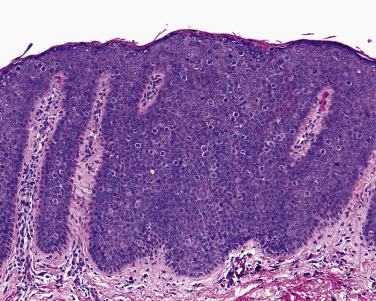
BCC denotes a spectrum of biologically indolent cutaneous epithelial tumors composed of hyperchromatic basaloid cells in a variety of morphologic patterns, set within a characteristic fibromucinous stroma. The tumor is largely actinic derived, although no intraepidermal precursor is known if one excludes the superficial basal cell carcinoma.
Clinically, basal cell carcinomas occur most often on sun-exposed areas, particularly the face, of white adults. They can, however, occur at any cutaneous site and in any race. Occurrence in young persons, other than in the context of nevus sebaceus, nevoid basal cell carcinoma syndrome, Basex syndrome, or Rombo syndrome is rare, but isolated basal cell carcinomas can be seen in youg adults.
Three syndromes that have multiple BCCs as a feature include nevoid basal cell carcinoma syndrome (Gorlin syndrome), Basex syndrome, and Rombo syndrome.
Gorlin syndrome is characterized by BCCs, odontogenic jaw cysts, pitted depression of the hands and feet, osseous anomalies of the ribs, spine, and skull, and characteristic facies (frontal bossing, hypoplastic maxilla, a broad nasal root, and true ocular hypertelorism). This genetic disorder presents in an autosomal dominant pattern. There is a mutation of the patched tumor suppressor gene located on chromosome 9.
Cutaneous symptoms: Local invasion of an aggressive BCC may lead to pain or symptoms (e.g., neurologic) related to local invasion. Metastases are extremely rare.
Neurologic symptoms: Medulloblastoma, a cerebellar tumor of young childhood, may present with neurologic symptoms in a child who is affected.
Genitourinary symptoms: Ovarian fibromas are usually asymptomatic, but they may present with pain secondary to torsion.
Dental symptoms: Odontogenic keratocysts may be asymptomatic, or they may present with jaw pain or abnormal dentition.
Basex syndrome is another autosomally dominant inherited disorder. It is characterized by multiple BCCs of the face, follicular atrophoderma on the extremities, localized or generalized hypohidrosis, and hypotrichosis.
Rombo syndrome is a rare condition characterized by the presence of atrophoderma vermiculatum of the face, multiple milia, telangiectases, acral erythema, and a propensity to develop basal cell carcinomas.
The large majority of basal cell carcinomas can be cured by simple excision, but deeply infiltrative lesions are recalcitrant to excision because of extensive sclerosis, which obscures the infiltrative growth pattern, or due to factors such as perineurial invasion. The differential diagnosis is usually with actinic keratosis, seborrheic keratosis, Bowen disease, squamous cell carcinoma, Merkel cell carcinoma (MCC), and (rarely) malignant melanoma.
Histologically, basal cell carcinoma has numerous cytologic variants and growth patterns. The insular pattern is most characteristic, accounting for most of the nodular clinical presentations. Variably sized separate or fused, cystic or solid islands of basaloid cells are observed ( Fig. 23.32 ), usually bordered by a palisaded outer row of cells, which may be separated from the stroma, the so-called retraction artifact ( Fig. 23.33 ). The adjacent stroma is fibroblastic, myxoid, or both. Mucin may be present within the tumor or within the stroma or in both ( Fig. 23.34 ). The mucin deposits can be abundant to evoke the diagnosis of mucinous carcinoma. A simple way to differentiate between both is a PAS stain. The mucin of mucinous carcinoma is PAS positive, while the one in basal cell carcinoma is negative. Additional patterns of small islands, netlike ribbons or trabeculae, alveolar nests, or mixtures of these may coexist in any given tumor. Secondary findings of epithelial-derived amyloid or areas of central necrosis are observed occasionally; often, melanin pigment is seen in the tumor lobules or in the adjacent stroma. In addition, one may observe ducts, which enter the tumor from below and contain inspissated eosinophilic material. Uncommonly, microcavities filled with parakeratotic infundibular or tricholemmal keratinization may be found. Foci of calcification are observed rarely.
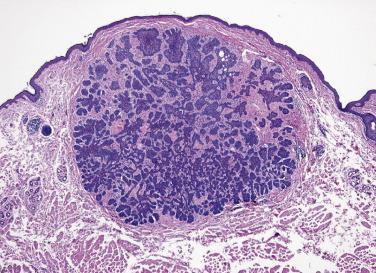
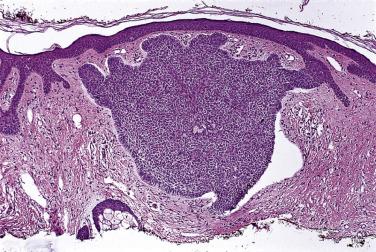
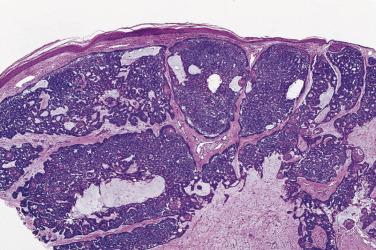
Cytologically, the vast majority of tumors consist of small, uniform cells, many of which are apoptotic. Occasional cells may be in mitosis. Unusual cases may harbor zones with pleomorphic tumor cells, clear cells, granular cells, signet ring cells, or myoepithelial-like cells.
Other growth patterns of basal cell carcinoma include the superficial multicentric and the morpheic (sclerotic) variants.
Superficial basal cell carcinoma typically presents as a clinical plaque, often in the clinical differential with Bowen disease. Histologically, the basaloid islands are discontinuous and are peninsular, budlike expansions from the epidermis, extending only into the superficial dermis ( Fig. 23.35 ). An inflammatory host response is noted typically, which may be a clue in the diagnosis of superficially biopsied lesions. Superficial basal cell carcinomas may develop lobular invasive components. Thus it is tempting to postulate that the superficial variant represents an in situ lesion. On the other hand, superficial basal cell carcinomas may represent a sui generis lesion.
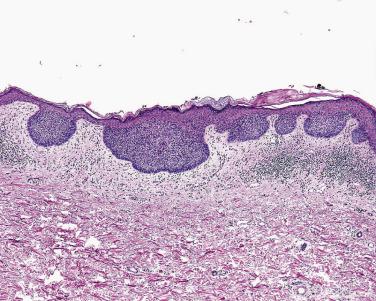
The sclerotic or morpheic pattern is clinically a flat scarlike patch. Histologically, the collagenous stroma represents over 50% of the tumor mass. The basaloid cells are typically arranged in thin linear strands. The stroma is usually dense and reactive ( Fig. 23.36 ). Great care must be made in the diagnosis of negative margins in such tumors, as the tumor cells and skin adnexa may both be compressed and bear similarity to one another. The differential diagnosis of these lesions is critical: desmoplastic trichoepithelioma (TE), microcystic adnexal carcinoma, and metastatic breast carcinoma.
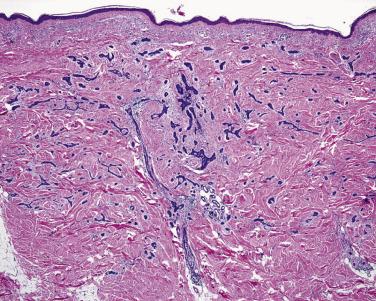
The classic nonkeratinizing basal cell carcinomas are Ber-Ep4 positive. Tumors with areas of squamoid differentiation are partially negative or negative. On the other hand, basaloid adnexal tumors of hair germ differentiation, such as trichoepitheliomas and trichoblastomas, are positive. Some basal cell carcinomas are actin positive.
In some basal cell carcinomas, one may identify focal patterns characteristic of tumors, which, in their fully developed forms, are separated from basal cell carcinoma on biologic as well as histologic grounds. Examples include basal cell carcinomas with ductal, sebaceous ( Fig. 23.37 ), follicular, or keratotic differentiation zones with thickened basement membranes, or all of these patterns. Some cases even have neuroendocrine features. With the exception of the keratotic tumors, we classify these as basal cell carcinomas when an area of the tumor has the growth pattern within the spectrum of conventional basal cell carcinoma. Exceptions to this rule would be the finding of coexistent tumor patterns that would confer a poorer prognosis, such as the so-called eccrine epithelioma, which has been characterized rather poorly but should probably be classified in the adnexal carcinoma group. In keratotic basaloid tumors, most are classified as basal cell carcinomas unless keratinization is extensive and the growth pattern is unusually infiltrative, in which case the term basaloid carcinoma is preferred; others have regarded such cases as basosquamous carcinoma.
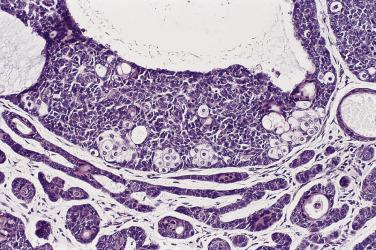
In 1990, Walsh and Ackerman proposed the term infundibulocystic BCC . Infundibulocystic BCC is described as a small, well-circumscribed lesion associated with infundibular cysts and basaloid cells, similar to rudimentary follicular bulbs and papillae, arranged in small, uniform aggregations and anastomosing cords ( Fig. 23.38 ). Such tumor is either the same or has a strong similarity to the so-called basaloid follicular hamartoma, including PHLDA1 and CK20 expression.
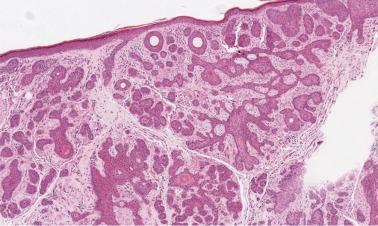
Fibroepithelioma of Pinkus (FEP) was first described by Pinkus as a premalignant fibroepithelial tumor; later, it was subclassified as a subtype of basal cell carcinoma. Histologically, the tumors are characterized by tumor islands and anastomosing strands of basaloid, often palisading cells, embedded in a fibromatous stroma ( Fig. 23.39 ). The tumors have a predilection for women, and they are more frequently located in the lumbosacral region. Using PHLDA1, the basaloid proliferative areas of FEP are negative for the marker. In contrast, the epidermis surrounding the tumor that has a hyperplastic pattern stains positive for this marker. Those areas of epidermal hyperplasia also contain a rich number of CK20-positive Merkel cells. Some authors consider the lesion to be follicular in nature akin to a trichoepithelioma or trichoblastoma.
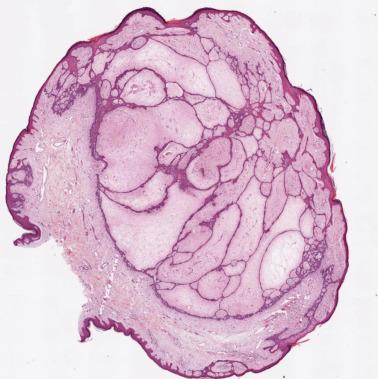
Because most basal cell carcinomas are indolent, local excision, especially when utilizing specialized techniques such as Mohs surgery, provide long-term cures in over 90% of cases, even when the tumors are enormous. Among the pitfalls at frozen section, folliculocentric basaloid zones or mantleomas or follicular tumorlets are similar to basal cell carcinomas and must be differentiated from them.
In most cases, basal cell carcinoma can be diagnosed by its H&E patterns. In rare cases, differentiation from squamous cell carcinoma by immunohistochemistry may be required. Use of the antibody to Ber-Ep4 is often helpful. Differential diagnoses include other basaloid neoplasms, often of adnexal differentiation: trichoblastomas, trichoepitheliomas, poromas, and Merkel cell carcinoma. Superficial lesions may mimic actinic keratoses.
Basal cell carcinomas with expression of neuroendocrine markers have been reported. It is unclear the significance and prevalence of this finding, since basal cell carcinomas have not been systematically studied for these markers. There are extremely rare cases of metastatic lesions in which the primary cutaneous lesion has been classified as basal cell carcinoma. Approximately two-thirds of these originate from the face. Those lesions greater than 3 cm in diameter have approximately a 1.9% incidence of metastasis, and the overall rate of metastases for morpheic basal cell carcinoma is less than 1%. Patients with tumors classified as T3 and T4 lesions ideally should be followed up for 10 or more years for the remote possibility of the development of a metastasis. For practical purposes, however, most basal cell carcinomas are not capable of metastasis, at least in the stage at which most are diagnosed and treated.
Squamous cell carcinoma denotes a range of tumors composed of abnormal squamous cells that have extended beyond the in situ phase of growth. They are, at the time of diagnosis, found within the dermis or beyond, including those that are metastatic to other sites.
Clinically, squamous cell carcinoma usually presents as a lesion on actinically exposed skin of middle-aged adults. The lesions range from a skin-colored or pigmented plaque to a scaly nodule or ulcerated tumor. In some cases, there is no clear association with sun exposure. These variants include verrucous carcinomas and chemical-associated squamous carcinomas, such as those associated with arsenic exposure. Biologically, squamous carcinomas are usually indolent unless they are present deep to the level of the sweat gland coils and long-standing ; those less than 2 mm thick confer no statistical risk of metastasis. Verrucous carcinomas are usually located on mucosal sites, such as the oral mucosa, cervix, or glans penis (giant condyloma); in the skin they are usually located on the plantar surface of the foot. They are locally destructive, but only exceptional cases spread beyond the primary site. Typically, the differential diagnosis of the actinically distributed lesions is limited to keratoacanthoma and basal cell carcinoma, but some can be confused with seborrheic keratoses and, in the pigmented forms, malignant melanoma. In the case of verrucous carcinoma, the differential diagnosis is with verruca plantaris.
Histologically, the most common pattern consists of lobules of squamous cells with abundant keratinization. There is usually a modest to marked degree of cytologic pleomorphism, characterized not only by high nuclear to cytoplasmic ratios, but also apoptotic cells and cells with typical and atypical mitosis. Early invasive lesions can present subtle single cell invasion of the papillary dermis ( Fig. 23.40 ). Well-differentiated squamous cell carcinomas show a relative mature keratinization ( Figs. 23.41 and 23.42 ). In some of these cases, the differential diagnosis with keratoacanthoma can be difficult (see Table 23.2 ). In the acantholytic variant, the lobular architecture is intact, but the squamous cells are dyshesive or acantholytic ( Fig. 23.43 ). This results in similarity with glandular tumors, such as adenocarcinoma, ductal adnexal carcinomas, or even angiosarcoma. Sometimes the acantholytic squamous cell carcinomas can display thin chords with extensive acantholysis and absent keratinization, which can closely mimic angiosacoma. In more aggressive forms, the growth pattern is that of infiltrative strands of squamous cells or individual squamous cells, rather than squamous cell lobules. In such cases, the finding of perineurial or vascular invasion is quite common, and it confers an unfavorable prognosis. Currently, a pathology report should include the presence or absence of perineural invasion and diameter of the nerve involved. Measurement of thickness as done in melanomas has been also recommended. This is more difficult, since most carcinomas do not have an overlying granular cell layer and have an irregular verrucous nature. Furthermore, there has not been any large series of cases to validate its use and possible cutoff points as in melanoma, nor are there defined methodology guidelines of how to measure these tumors at this writing.
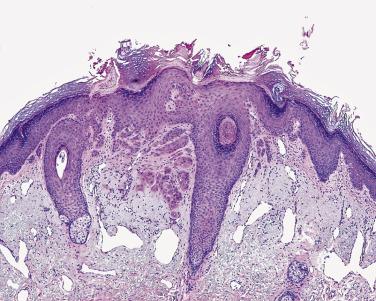
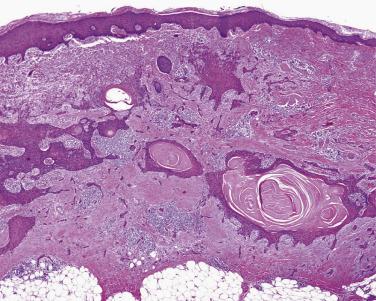
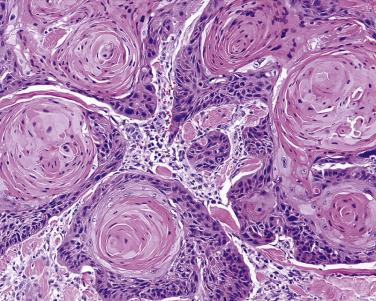
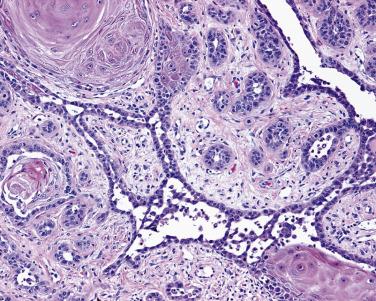
Some cases show very prominent stromal desmoplasia (reminiscent of sclerosing basal cell carcinoma), and this pattern also is associated with more aggressive behavior. Less common cell types seen in squamous carcinomas include bowenoid ( Fig. 23.44 ), clear cell ( Fig. 23.45 ), signet ring cell, basaloid cell, and spindle cell types ( Fig. 23.46 ), which can be confused with glandular tumors, basal cell carcinoma, and other spindle cell tumors, respectively.
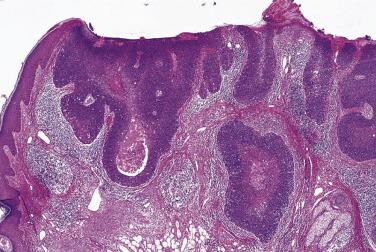
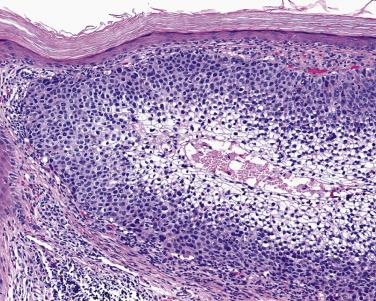
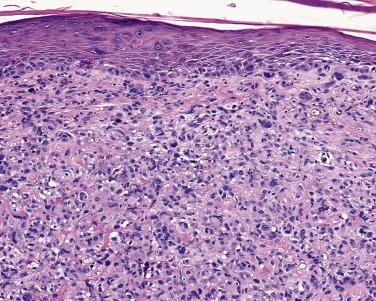
Immunohistochemically, squamous cell carcinomas are usually positive with AE1/AE3 cytokeratins and EMA, but often lack CAM5.2 and Ber-Ep4. Typically, these lesions lack positivity for S100 protein and mesenchymal markers other than vimentin.
Other growth patterns of squamous carcinoma include those similar to carcinoma in situ, but they either have deeply penetrated the dermis or have an exophytic, papillary pattern rather than infiltrative growth. Metaplastic (carcinosarcomatous) variants contain unusual homologous (spindle cell) and heterologous (distinct sarcomatous) components, but in spite of the worrisome pleomorphism may not necessarily be associated with a poor prognosis. An unusual variant is known as spindle squamous cell carcinoma with osteoclast-like stroma. This tumor is lagely undifferentiated and contains numerous osteoclast-like cells. The mononuclear cell component is positive for keratin, and the osteoclastic component is positive for macrophage markers, such as CD68.
The most common of skin cancers are actinically related. These are basal and squamous cell carcinomas arising in sun-damaged skin. Traditionally common in individuals who worked in open air (e.g., sailors, farmers), these showed a great upsurge in more recent times with the popularization of recreational sunbathing.
This has led to a widespread educational campaign on the potential oncologic threat of unprotected sun exposure and the judicious use of protecting clothing and sunscreens.
Nevertheless, there are other causes, albeit rare, of cutaneous oncogenesis, including chemical, viral, chronic scarring processes, postradiation, and chronic heat damage.
Scar tissue carcinoma is a common type of squamous cell of the body and extremities. The best known is Marjolin ulcer, the burn scar that was not grafted and that healed after months of treatment. Probably of a similar etiology are the squamous carcinomas developing in chronic leg ulcers, acne conglobate, hidradenitis suppurativa, the sinuses of osteomyelitis, other chronic sinuses and fistulas, and old scars on amputation stumps.
The carcinomas arising in the setting of chronic heat damage occur almost exclusively in very cold areas, in which people resort to fire heat to stay warm. Sometimes these may be preceeded by a dermatosis akin to actinic keratoses known as erythema ab igne . This happens particularly in those cultures with curious practices. Kangri burn cancer was described in 1923 by Neve, a surgeon at the Kashmir Mission Hospital. The kangri is an earthenware bowl 5 to 6 inches in diameter, surrounded by basketwork, heated by burning wood and charcoal, and worn under a single loose garment against the skin of the abdomen or inner thighs. Many elderly Kashmiris who have used the kangri for years show a chronic heat dermatitis with many burn scars. There is pigmentation with dry keratotic skin. Squamous cancer develops as an infiltration under the horny surface with ulceration later. Since 1881, of the 2491 operations for skin carcinomas, approximately 2000 (84%) were for kangri cancer. Similar cancers have been reported from Japan resulting from the use of a kairo, a tin box filled with burning charcoal and worn against the skin of the abdomen.
Cross in 1967 reported 162 cases in 5 years of squamous carcinoma of the middle third of the lower leg in elderly Irish women. All these patients came from rural areas and gave a history of working close to turf (peat) fires most of their lives. Similarly, it occurs in people who used heated bricks in beds to keep warm. The carcinomas originated on the sole of the feet.
The earliest change is the condition erythema ab igne. It has many similarities with actinic keratosis, including elastosis and epidermal atypia.
These interesting conditions are very rare, particularly those induced by heat, and are unlikely to be seen in those areas were the climate is more temperate.
Arsenic-induced skin lesions may include keratosis, squamous cell carcinoma, and basal cell carcinoma. Arsenic keratosis presents with hyperkeratosis, parakeratosis, arsenic pigmentation, and squamous cell carcinoma in situ (indistinguishable from regular Bowen disease). Within the spectrum of keratotic lesion, arsenic keratosis may be differentiated from the more commonly diagnosed actinic keratosis by the absence of epidermal atrophy and basophilic degeneration of the upper dermis. All arsenic skin changes, including keratoses, tend to occur in nonexposed sites with an absence of dermal solar elastosis noted histologically. The lesions are normally most pronounced on the feet and hands, although they can occur on the trunk and other areas of the extremities.
Squamous cell carcinoma in situ is the most common form of skin cancer induced by arsenic, which may develop from 2 to 20 years after exposure. Bowen disease is an intraepidermal squamous cell carcinoma, referred to as squamous cell carcinoma in situ . It is considered a precancerous dermatosis, in the same group as leukoplakia, senile keratosis, and xeroderma pigmentosum. Histologically, Bowen disease presents as intraepithelial atypia, with marked variation in cell and nuclear size and shape. Multinucleate giant cells and numerous mitotic figures are observed throughout all levels of the epidermis.
Arsenic-induced skin lesions assume protean forms. Besides keratotic lesions and skin cancers, pigmentation disorders represent another characteristic manifestation of arsenic exposure. The pigmentation may present as hyperpigmentation or hypopigmentation. Hyperpigmentation is reported to be one of the most common skin changes seen in people chronically exposed to arsenic. It most often occurs on the trunk, but may be more accentuated in areas that are more heavily pigmented, such as the groin and areola. Histologic examination reveals increased melanin pigment in melanocytes in the basal cell of the epidermis extending up to the granular cell layer. Signs of arsenic pigmentation may herald the later development of skin cancer. In one study of patients showing signs of arsenical pigmentation, nearly 90% developed skin cancer. Hypopigmentation occurs as well and may show a characteristic raindrop pattern.
Verrucous carcinoma is a cytologically very well-differentiated form of squamous carcinoma. Architecturally, it is similar to verruca vulgaris but differs in its locally destructive pattern of growth, which may include osteoinvasion. The squamous cell lobules are closely apposed and often contain microabscesses along the advancing front, which is compared with rabbit burrows; thus the term carcinoma cuniculatum is sometimes used for these tumors. Immunohistochemistry has so far failed to reveal virus-associated antigens in the majority of cases, but in rare cases HPV has been detected. Superficial biopsies are especially difficult to evaluate in cases of verrucous carcinoma. Thus this diagnosis should be suspected in any deeply positioned verrucous squamous lesion that is histologically bland and that has been present clinically for a period of months to years, particularly in tumor-prone areas: the ball and sole of the foot, external genitalia, and oral cavity. Clinical correlation, including examination of radiographs, is essential in making this diagnosis.
Described as a tumor seemingly combining histologic features of basal cell carcinoma and squamous cell carcinoma, basosquamous carcinoma has not been universally recognized as a distinct cutaneous neoplasm. Most lesions called basosquamous carcinoma are either keratotic variants of BBC or the basaloid variant of SCC. The lesion is perceived as a more aggressive carcinoma capable of metastasis.
The concept is revived and discarded periodically. No general agreement has been agreed as to what are the diagnostic criteria or natural history. Based on our experience, most cases reviewed in consultation are basaloid squamous cell carcinomas, a name incongruent in itself.
Cutaneous neuroendocrine carcinoma is characterized by a spectrum of small blue-cell tumors that are found usually within the dermis. Purely intraepidermal tumors are rare. The neoplasms have histologic features of epithelial cells and neuroendocrine cells.
Neuroendocrine carcinoma most commonly arises in the elderly and has a predilection for the upper body, although the trunk and lower limbs may be involved. The clinical differential diagnosis is nonspecific. The prognosis of the tumors has been variable. However, in most cases, these are aggressive neoplasms with a tendency to repeated recurrences and eventual metastasis.
Histologically, one may observe a range of trabecular to insular or diffuse growth patterns, any or all of which may coexist within an individual tumor ( Fig. 23.47 ). The lesion often fills the entire dermis, usually with sparing of the epidermis by a thin grenz zone. Uncommon findings include epidermotropism, association with keratinocyte pleomorphism similar to Bowen disease, and ductal components. Cytologically, the tumor cells typically are monomorphic. The cytoplasm is usually scant and is amphophilic to eosinophilic. The nuclei are relatively uniform, grayish, and may exhibit nuclear molding similar to visceral small cell carcinomas ( Fig. 23.48 ); however, in contrast with most cases of the latter, the cells in cutaneous neuroendocrine carcinomas are readily discernable, lacking crush artifact. The chromatin pattern is finely granular and dusty looking; small nucleoli may be observed. Histochemically, silver stains are usually negative, corresponding to the paucity of neurosecretory granules in the tumor cells. On occasion, there is a component of squamous cell carcinoma. Immunohistochemically there is considerable variation of staining patterns. Typically, a pattern of paranuclear dotlike condensations of filaments, which are positive for low molecular weight keratins (AE1/AE3, CAM5.2, or cytokeratin 20 [CK20]), is observed. The CK20 positivity is a valuable discriminant from other types of small cell carcinoma ( Fig. 23.49 ), although it can be negative at times. Most cases are positive for neurofilament protein (NFP). Some cases of MCC can be positive for CK7. Another important discriminant between MCC and small cell carcinoma is thyroid transcripton factor-1 (TTF1), although recently isolated case reports of MCC with TTF1 expression have been published. Epithelial membrane antigen (EMA), neuron-specific enolase (NSE), chromogranin, and Ber-Ep4 also are positive in most tumors. S100 protein, carcinoembryonic antigen (CEA), and lymphocyte markers are consistently negative. MCCs are also frequently positive for terminal deoxynucleotidyl transferase (TdT) and PAX5. Such markers can lead to a misdiagnosis of hematologic malignancy (blastic tumors and chronic lymphocytic leukemia). Ultrastructurally, the tumor cells are joined to each other by macula adherens–type junctions. Characteristic paranuclear filaments arranged in circular aggregates are seen, and neurosecretory granules 80 to 120 nm in size are also observed in properly fixed specimens. The identification of the Merkel cell polyomavirus (MCPyV) was a critical advance in our understanding of MCC biology. MCPyV DNA integrates into the host genome of approximately 70% to 80% of MCCs and is thought to be an important pathogenic driver in a subset of MCCs. The large T antigen of the virus can also now be detected quite easily by immunohistochemistry, which is valuable in the routine diagnostic setting. It is also particularly important to highlight that MCPyV+ cases in association with increased density of CD3+, CD8+ T cells at the periphery of the tumor show a better survival in comparison with MCPyV- cases. Notoriously, patients with MCC have shown excellent responses to PD1 blockade, which led to approval by the US Food and Drug Administration (FDA) of such medication in patients with metastatic disease.
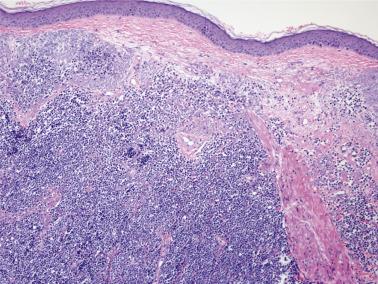
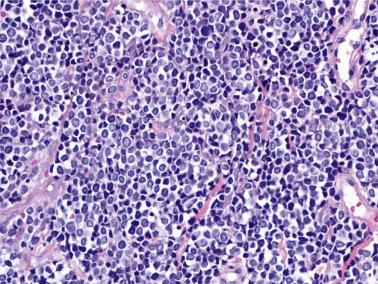
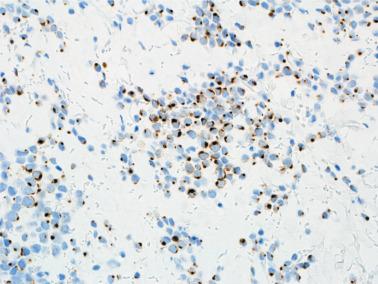
The histologic differential diagnosis is usually limited but includes small cell malignant melanoma, cutaneous lymphoma, neuroendocrine basal cell carcinoma (rarely), metastatic small cell carcinoma, and Ewing sarcoma. Among these, distinction from metastatic small cell carcinoma is often the most difficult; as always, it is advisable to check the clinical history carefully and perhaps suggest a chest radiograph. TTF1 may aid in the diagnosis, since it is positive in metastatic visceral small cell carcinomas and negative in virtually all primary cutaneous Merkel cell carcinomas. More recently, a very uncommon group of tumors described as cutaneous large cell neuroendocrine carcinomas have been reported. As opposed to MCC, such tumors show a weak, membranous and focal staining pattern for CK20 and are negative for NFP.
Lymphoepithelioma-like carcinoma of the skin (LELCS) is a rare tumor of unknown etiology, low malignant potential, and with microscopic resemblance to undifferentiated nasopharyngeal carcinoma. Clinically, it presents as a flesh-colored firm nodule or plaque on the face, scalp, or shoulder of middle-aged to elderly individuals. Histologically, LELCS is composed of islands of epithelial cells with large vesicular nuclei surrounded and permeated by a dense lymphoplasmacytic infiltrate ( Fig. 23.50 ).
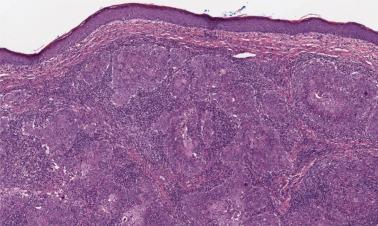
The neoplastic cells show strong positive reaction with pancytokeratin ( Fig. 23.51 ). The surrounding lymphoid infiltrate exhibits a positive reaction with the T-cell and B-cell markers CD3 and CD20, respectively. All tumors showed strong p63 protein reactivity. Stains for Epstein-Barr virus (EBV) latent membrane protein 1, CK7, CK20, neuron-specific enolase, and carcinoembryonic antigen were negative in all of the cases studied. The differential diagnosis includes basal cell carcinoma, squamous cell carcinoma, lymphoma, pseudolymphoma, and Merkel cell carcinoma.
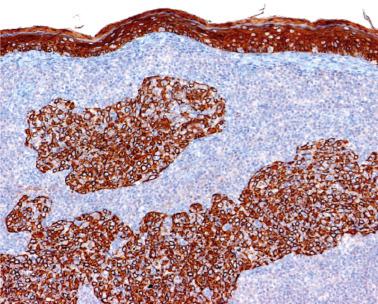
The conceptual definition of neoplasms with a biphasic phenotype is complicated. Neoplasms with seemingly dual phenotype are very rare. CS, a malignant tumor that simultaneously expresses malignant epithelial (carcinoma) and mesenchymal (sarcomatous) components, was first described by Virchow in the 19th century and has been reported in most organs.
Due to conceptual interpretations, different names have been applied. With the improvement of immunohistochemical stains, better definition of this group has been accomplished.
CS, also known as metaplastic carcinoma, biphasic sarcomatoid carcinoma, carcinoma with pseudosarcomatous stroma, and sarcomatoid carcinoma, simply put, are rare neoplasms that seemingly combine malignant epithelial and mesenchymal differentiation ( Fig. 23.52 ). It can be encountered in a wide variety of sites (breast, genitourinary tract, lung, salivary glands, and thymus). Two antithetical hypotheses have been used to explain the histogenesis of these complex tumors: (1) the convergence (multiclonal) hypothesis, in which the tumor arises from two or more stem cells of mesenchymal and epithelial origins, and (2) the divergence (monoclonal) hypothesis, in which the tumor is derived from a single totipotential cell that undergoes divergent differentiation into separate epithelial and mesenchymal elements in either a synchronous or metachronous fashion. To date, most molecular studies overwhelming favor monoclonal origin for CS with further accumulation of aberrations that lead to its biphasic/divergent phenotype. An alternative explanation is the fact that while the epithelial component is easily recognizable, the spindle-shaped mesenchymal component is difficult to characterize. This is largely due to the fact that immunostains have low sensitivity. Thus cellular markers may be present in too low amounts to be optically visible. Such is clearly the case for intermediate filaments, including keratins. Those can be identified by electron microscopy, a technology seldom used at the current time. Cutaneous CS is uncommon, with only 38 cases reported as such to date. a
a References .
This does not include cases reported using alternative nomenclature. It is clear that if all these reported lesions were studied today with improved diagnostic techniques, then they might be reclassified.
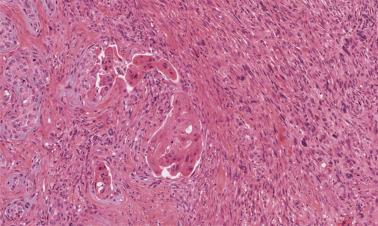
An adnexal tumor is defined as a benign or malignant lesion with differentiation similar to one or more types of adnexal epithelium (and associated stroma) found in normal skin. The lesions can be solitary or multiple. Some can occur as an attribute of a syndrome that can arise either sporadically or in a familial context.
These lesions are discussed in the context of the four types of adnexal structure usually identified in skin: hair follicles, sebaceous glands, apocrine and eccrine glands, and nails. It must be realized, however, that any particular lesion may show one or more lines of differentiation. In these cases, the tumor is usually classified by its predominant component. Apoeccrine glands combine secretory features of apocrine and eccrine epithelium. These glands develop in puberty and comprise up to 10% of the sweat glands in the axilla. They are also found on the face and scalp and are very conspicuous in nevus sebaceous. The presence of apoeccrine differentiation occurs in some neoplasms. Other cutaneous glandular neoplasms arise from the anogenital glands. These are similar to mammary tissue and produce tumors similar to breast neoplasms.
Folliculosebaceous
Follicular
Infundibular
Tricholemmal
Matrical
Hair germ
Sebaceous
Sebocytic
Ductal
Sebomatrical
Sweat gland
Eccrine
Apocrine
Apoeccrine
Ductal
Myoepithelial
Follicular tumors can be regarded as a group of lesions differentiating toward one or more portions of the hair follicle, which consist of the hair germ, matrix, cortex, inner and outer sheath below the bulge, and the sheath from the bulge to the surface. Additionally, the perifollicular fibrous sheath is prominent in some of these tumors.
Nevus or hamartoma, in this context, implies that hairs are present in the proper dermal location but have an abnormal morphology, quantity, or relationship to the adjacent normal skin. The lesions are not tumorlike. Hair nevus encompasses a wide spectrum of lesions that range from a small tumorlike lesion to large patches in which a different morphologic type of hair is produced.
This is the most common type of follicular cyst (~80%). Clinically, it can be located on any area of hairy skin, but is usually found on the head, neck, or trunk. It ranges in size from 2 mm to 5 cm and can be treated with simple excision or observation only. The differential diagnosis is wide. The concomitant occurrence of multiple infundibular cysts with colonic polyps, desmoid tumors, and osteomas is known as Gardner syndrome.
Histologically, the cyst is usually not seen connected to the surface, but occasionally a small connection can be identified. It is lined by stratified squamous epithelium that matures through a granular layer and produces basketweave and laminated flakes of orthokeratin similar to that of the epidermis ( Fig. 23.53 ). Occasional cysts are hyperpigmented, usually in persons with dark skin. In rare instances, changes such as carcinoma in situ, molluscum contagiosum, acantholytic dyskeratosis, seborrheic keratosis, or HPV-induced verrucous changes are present. If there is rupture of the cyst wall, a foreign-body granulomatous keratin reaction results.
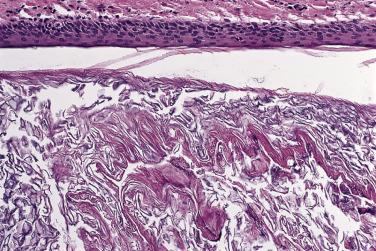
This is a rare stratified squamous-lined cyst that contains laminated keratin and numerous hair shafts. Clinically it has been identified on the head, neck, trunk, and (rarely) the limbs. It is usually less than 2 cm in diameter and typically has a dark hue from the Tyndall effect. The clinical differential diagnosis is with blue nevus, hidrocystoma, and cystic basal cell carcinoma.
Histologically it has a narrow opening to the surface. It is lined by stratified squamous epithelium that matures through a granular zone and contains laminated keratin and numerous hairs within the cyst cavity. Typically it is not associated with other appendages. The differential diagnosis is with eruptive vellus hair cyst.
This is the second most common type of follicular cyst (~10%–15% of cases) and historically was called sebaceous cyst, although many terms were uncritically used for cysts of all histologic types in the past. Clinically, a tricholemmal cyst almost always occurs on the scalp, but other sites on the trunk or extremities may be affected. Women are affected more commonly than men. Simple excision is curative. The differential diagnosis is with a variety of dermal tumors.
Histologically, the epithelial lining exhibits keratinocyte maturation though little, if any, granular layer. The lining cells are large and contain abundant cytoplasm toward the apical portions, similar to the keratinization of the isthmic portion of the catagen hair follicle. Keratinization is abrupt and dense ( Fig. 23.54 ), in contrast with the laminated keratin of the infundibular cyst. In some there is hyperplasia of the lining similar to proliferative tricholemmal cysts (pilar tumor) ( Fig. 23.55 ), which is the primary differential diagnosis.

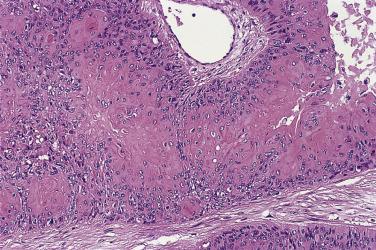
This is a cyst with two or more types of lining epithelium, such as infundibular and tricholemmal, but a very broad spectrum could be conceptualized and is documented. Such changes may be helpful in the future to identify syndromes, such as Gardner syndrome, in which multiple cysts, some of which have linings similar to infundibular and matrical epithelium, are an attribute. If one examines all cysts closely, subtle mixed changes can often be identified, but it is uncommon to see distinctly different types of epithelium within a particular cyst.
This is a rare lesion consisting of multiple small cysts, which often appear rapidly, showing infundibular, sebaceous duct, and focal isthmus-catagen maturation, and containing vellus hairs. Some authors believe that these are simply variants of steatocystoma.
The cysts usually become clinically evident within the first three decades of life, affecting whites predominantly in the first two decades of life and orientals in the second and third decades. Some kindreds have been affected, which suggests a genetic association in some cases. The lesions are papules of varying color, measuring 1 to 4 mm in diameter, some of which have central umbilication. No Köbner phenomenon has ever been reported with their development. There is no sex predilection. The lesions appear, in decreasing order, on the chest, arms, face, and legs. Half of the cases with chest involvement have no involvement elsewhere. The clinical differential diagnosis is with acne, steatocystoma multiplex, folliculitis, keratosis pilaris, trichostasis spinulosa, perforating disorders, and milia. Most lesions are recalcitrant to therapy, but limited success has been achieved with carbon dioxide laser and retinoic acid.
Histologically, there is infundibular maturation through a granular layer, but occasionally there is a corrugated lining, similar to a sebaceous duct, or a focal lining similar to an isthmus-catagen cyst. Numerous small hair shafts are seen within the cyst ( Fig. 23.56 ). Occasionally there are telogen follicles and (rarely) sebaceous glands or smooth muscle, or both. The histologic differential diagnosis is with steatocystoma, infundibular cyst, and pigmented follicular cyst.
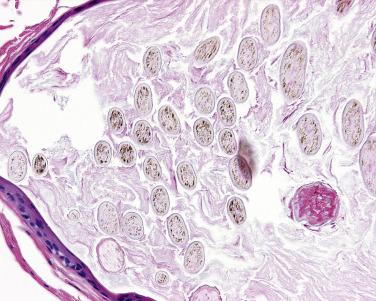
This is a small cyst, the lining of which is similar to the corrugated cuticle of the sebaceous duct. Sebaceous glands are usually associated with such cysts.
Clinically, these cysts arise usually in the second through fourth decades with an onset most often at or around puberty. They are usually skin-colored to blue-black papules that range from a few millimeters to several centimeters in size. If they are incised, a white fluid often exudes. The cysts are usually multiple (steatocystoma multiplex) but can be solitary (steatocystoma simplex). They are usually located on the chest, but they can also be found on the face, back, limbs, and (rarely) elsewhere. There is often an autosomal dominant pattern of inheritance if the cysts are multiple. Sometimes steatocystoma is associated with ectodermal dysplasia. For the multiple lesions, the differential diagnosis is with eruptive vellus hair cysts, Gardner syndrome, and acne conglobata. For the solitary lesions, the differential includes a wide variety of cysts and tumors. Therapy is usually unsuccessful, but isotretinoin and cryosurgery have been used with some limited efficacy.
Histologically there is an empty cyst with a serpiginous wall lined by thin squamous epithelium and surfaced by a corrugated cuticle ( Fig. 23.57 ). There is little to no granular layer. There may be an abortive epithelial track extending from the cyst to the epidermal surface. Sebaceous glands are commonly adjacent to, or directly contiguous with, the cyst wall. Occasional vellus hairs are found within such cysts ; rarely, a vellus hair germ is seen within the cyst wall. The differential diagnosis is with eruptive vellus hair cysts, dermoid cysts, cystic sebaceous hyperplasia, and pigmented follicular cyst.
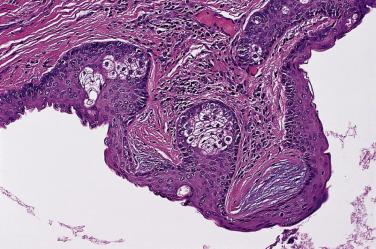
Recently, HPV57 and HPV60 have been identified in multiple palmoplantar cysts. HPV60 has also been recognized in nonpalmoplantar epidermal inclusion cysts (EICs), both free standing and some underlying facial warts. Some eruptive HPV-associated cysts have been described in the setting of epidermodysplasia verruciformis (EVD). Such cysts are more frequent in individuals of Japanese origin. Histologically, they are nearly identical to common infundibular-type cysts and have very coarse keratin hyaline granules in addition to viral cytopathic changes. In some circumstances, rare SCCs have been shown to arise from those cysts.
Hair cortex comedo was described originally in an article detailing two cases of a comedo-like clinical lesion that was histologically a keratinous plug with cornification similar to the cortex of the hair shaft. We have collected retrospectively and prospectively a series of 34 cases of hair cortex comedo. In our series, there was a slight female predominance (M:F of 1 : 1.4), and the mean patient age was 28.8 years. All lesions were solitary, distributed mainly on the head and neck or trunk, and were described clinically as a blue subcutaneous papule or nodule with cyst as the most common clinical differential diagnosis. Histologic examination showed a solitary, vertically oriented, uniformly sized oval nodule of compact laminated corneocytes sitting in a patulous invagination lined by epithelium similar to infundibulum, isthmus, or combinations of them; rarely, matric epithelium was identified. Entrapped melanin (30/34 cases), shadow cells (16/34 cases), and calcification (12/34 cases) were identified commonly. Remnants of a surrounding follicle were noted in 15 cases, with infundibular epithelium in 9 of the cases, isthmic epithelium in 3, and matric or supramatric epithelium (or both) in 3. There was an associated dense granulomatous infiltrate in the majority of the cases (25/34). While hair cortex comedo was thought originally to be a variant of dilated pore of Winer, we believe that these distinctive lesions, which are histologically characterized by a uniformly sized vertically oriented dermal plug of laminated keratin with entrapped melanin and surrounding granulomatous inflammation, are likely derived from matric or supramatric cells (or both).
This is a benign dermal and/or subcutaneous tumor that is histologically similar to the matric portion of the hair at the level of the bulb above the critical line. Clinically most of these lesions are solitary nodules located on the head, neck, or upper limb. They may be rubbery and pliable or hard and faceted, and they usually measure 5 mm to 2 cm in diameter. Rarely, they can be multiple, perforated, and/or rapidly progressive. They usually occur in the first two decades, but may present at any age. The clinical differential diagnosis is wide unless the lesion is faceted. Rare cases are associated with myotonic dystrophy. Simple excision is curative.
Histologically, the hallmark is that of basaloid lobules, which are contiguous with eosinophilic effete cells admixed with keratin; the latter are termed shadow cells ( Fig. 23.58 ). The basaloid cells are typically homogeneous and monomorphous, similar in size to the basaloid cells of basal cell carcinoma. Many of these cells may be in mitosis in any given histologic field. The shadow cells are anucleate but retain the essential morphology of the basaloid cells ( Fig. 23.59 ). As a secondary phenomenon, a giant cell infiltrate and dystrophic calcification are also usually present, presumably as a host response to the shadow cells and keratin. Lesions that contain a significant number of basaloid cells can be cystic; lesions that are devoid of the basaloid cells are typically solid tumors of shadow cells, calcification, and giant cell reaction. Lesions termed matricoma tend to be larger and retain more basaloid cells than conventional pilomatricomas. Another variant, termed proliferative pilomatricoma, consists of large, lobular proliferations of basaloid cells with small to large foci of shadow cells. Pilomatricoma-like changes have been observed in cysts of Gardner syndrome and, rarely, in organoid (sebaceus) nevi. Histochemically and ultrastructurally, pilomatricoma is similar to the hair matrix. The histologic differential diagnosis is with basal cell carcinoma, neuroendocrine carcinoma, and matric carcinoma. The diagnosis is typically straightforward unless the entire lesion is composed of basaloid cells, and the differential diagnosis is not initially considered.
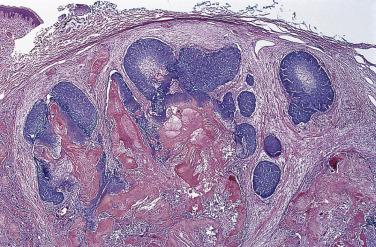
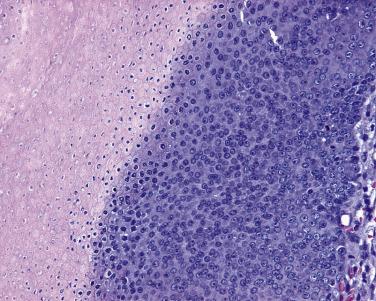
This refers to solitary lesions that range from small to large dilated follicular ostia, which usually occur on the upper lips of adults but may rarely be found at other sites. Histologically, they are simple, funnel-shaped structures that are deep within the dermis but are open to the surface ( Fig. 23.60 ). They are lined by infundibular epithelium and filled with dense, lamellar keratin. There is a range of acanthosis of the sac lining, but it is not pronounced. The clinical differential is with comedo and basal cell carcinoma; the histologic differential is with comedo.
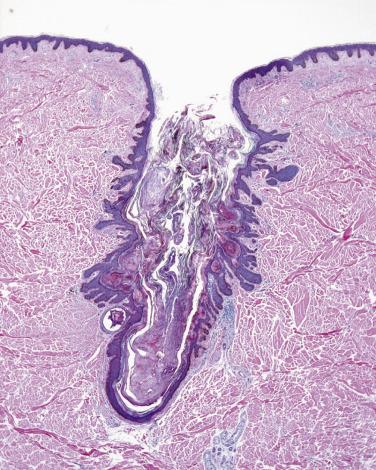
Hair cortex comedo, which contains a plug of hair cortex–like keratin, was originally thought to be an unusual variant of a dilated pore of Winer, but it is now believed to be a distinctive lesion likely derived from matric or supramatric cells and may be a variant of pilomatricoma.
When the lesion does not have an opening to the epidermis, it becomes a cystic lesion known as seborrheic keratosis-like cyst for its similarity to surface seborrheic keratoses.
These tumors are composed of small hair follicles that radiate around one or more cystlike dilatation(s) that often open to the skin surface. They often present as a small, facial, skin-covered nodule that may have a small central epidermal ostium. A whisker of white hair may emerge from the lesion; less commonly, large hairs may grow from the entire surface. They may develop at any age but are usually diagnosed in the second decade. Because many of these may be nodular and without an ostium, the clinical differential diagnosis includes a wide variety of tumors and tumorlike conditions.
Histologically, most trichofolliculomata are composed of a squamous epithelial-lined cyst that is centrally dilated and occasionally connected to the epidermis ( Fig. 23.61 ). The central cyst contains orthokeratotic, lamellar keratin, and the lining has prominent granular cell layers. Hairs are usually present within the cystic lumen. Although most lesions have only one cystic cavity, some are multilocular. Branching, in a spoke-wheel pattern from these cysts, are many vellus hairs with or without prominent sebaceous glands. Small hair germs may bud from these structures, and Merkel cells are easily identified within them. On rare occasions there are prominent sebaceous lobules resulting in a dermoid cyst–like structure that has been termed sebaceous trichofolliculoma . Also included within this spectrum are lesions termed folliculosebaceous cystic hamartoma . On the opposite end of the spectrum, few hairs may be present. In their place are simple squamous strands or buds.
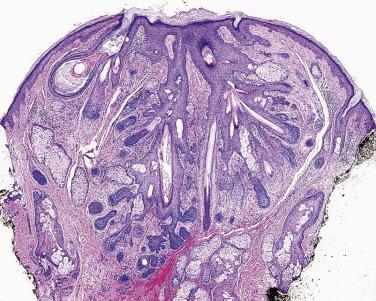
Trichoepithelioma denotes a spectrum of benign follicular epithelial-stromal tumors containing epithelial structures that are similar to one or more portions of a hair follicle and/or germ. It covers the broadest spectrum because it encompasses all lines of differentiation, in contrast with other hair and/or follicular tumors that are differentiated toward specific portions of the germ, hair, or follicle. We prefer to classify these lesions into classic (germ, sheath, and hair), trichoblastic (mostly germ), trichoadenoma (mostly infundibular or sheath at the isthmus), and desmoplastic types (a special case of germ, hair, and sheath in sclerotic stroma).
This type of tumor can exist as a familial multiple form (epithelioma adenoides cysticum) or as a solitary form. The multiple form becomes apparent in adolescence or adulthood and usually has a central facial distribution. The solitary tumors can be found on any portion of hair-bearing skin, but the head and neck are the most common sites. Rarely, trichoepitheliomata are associated with other adnexal tumors and syndromes.
Histologically, classic trichoepithelioma is a symmetric lesion ( Fig. 23.62 ) that contains a mixture of epithelial elements ranging from hair germs associated with papillary mesenchymal bodies (follicular papillae) ( Fig. 23.63 ), to small horn cysts, to lacelike reticular basaloid structures, to mature hairs (rarely). The stroma containing these structures is typically fibrotic, architecturally uniform from area to area, and directly abuts the tumor, in contrast with the retraction artifact of basal cell carcinoma. In some lesions, reactions, such as keratin granulomas, can occur secondary to rupture of horn cysts. Rarely, these lesions are associated with basal cell carcinoma.
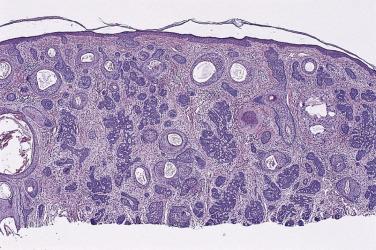
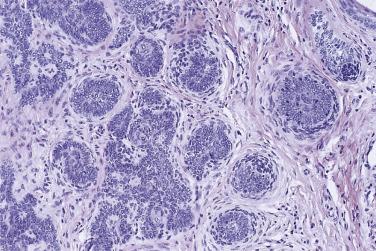
These are a range of tumors in which the epithelial elements are predominantly germs (trichoblasts) and which most commonly are associated with a stromal component ranging from minimal to extensive. The nomenclature of the variations within this group is dependent upon the amount of stroma, the number of germs, and any other epithelial elements that are present within an individual lesion. Lesions in this group can also be divided by the size and architectural features of the basaloid component.
Clinically, the lesion is solitary and is sometimes located in the deep dermis or subcutis, usually of the extremities, trunk, or pelvic region, but some have been located on the head and neck. Most are less than 1 cm in greatest dimension, but a few are large, measuring several centimeters in diameter. Typically they shell out easily and are cured by local excision. The clinical differential diagnosis is usually nonspecific.
Histologically, these lesions are almost always well circumscribed. Very few of these tumors contain horn cysts, in contrast with classic trichoepitheliomata. The most primitive lesion, the trichoblastoma, consists only of basaloid germs that are devoid of stroma and mesenchymal induction. A lesion with intermediate maturity (i.e., stromal differentiation and germs with mesenchymal induction) has been termed trichoblastic fibroma ( Fig. 23.64 ). These range from those with only germs and stroma, to stroma, germs, basaloid strands, and lacelike epithelial components. The most mature tumor has been known as trichogenic trichoblastoma, which is similar to the trichoblastoma, but, in addition, contains complete hair follicles. Unusual mucinous lesions of the skin that also contain germs are sometimes termed trichogenic myxomas . The principal differential diagnoses for any of these lesions are classic trichoepithelioma and basal cell carcinoma. Similar to BCC, TE are positive for Ber-Ep4. In the past, the use of CD34, CD10, and bcl2 were proposed to be useful adjunctive markers to distinguish between the two entities. However, the most reliable markers to differentiate those tumors appear to be CK20 and Ki67. CK20 is positive in isolated Merkel cells in TE, but is negative in BCC. The Ki67 is most frequently increased in BCC, with the exception of the more adenoid variants. A more recent marker, PHLDA1, has been shown to accurately discriminate between TE (positive) and BCC (negative).
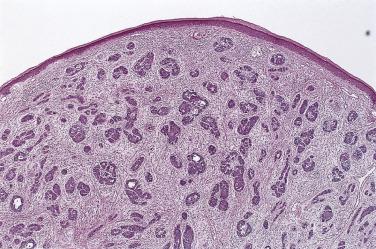
This is defined as a trichoepithelioma with prominent cystic spaces confined within a fibrotic stroma; it is not an adenoma because no glands are present. These lesions are similar to the infundibular portion of the hair follicle, rather than the germinal portion. Clinically, trichoadenomas are usually nodular to verrucous.
Histologically, trichoadenoma is a symmetric lesion with a mixture of horn cysts that may or may not be connected to each other by strands of basaloid cells ( Fig. 23.65 ). Occasionally keratin granulomas can be seen if the horn cysts rupture. Occasional lesions are surfaced by verrucous hyperplasia.
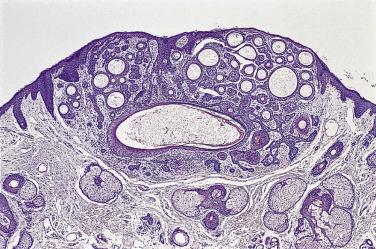
This is a range of symmetric, well-demarcated tumors composed of compressed follicular epithelium within a desmoplastic dermis. The subcutis is not involved.
Clinically, these lesions are usually solitary, but can rarely be multiple. Familial cases of either type have been reported. The tumor is found usually on the cheeks of women. Most are less than 1 cm in diameter and have a central dell. Local excision is curative. The principal clinical differential diagnoses are with morpheic basal cell carcinoma and microcystic adnexal carcinoma.
Histologically, these lesions are symmetric with a well-demarcated, fibrotic zone that separates the tumor from the normal skin ( Fig. 23.66 ). Superficially, in addition to the compressed epithelial strands, there may be small horn cysts and keratin granulomas if the cysts are ruptured. Deep, small hair germs may be identified occasionally. While eccrine glands and ducts can be present within the tumor, these are involved only secondarily. There is evidence suggesting that these lesions contain Merkel cells, in contrast with their absence in morpheic basal cell carcinoma.
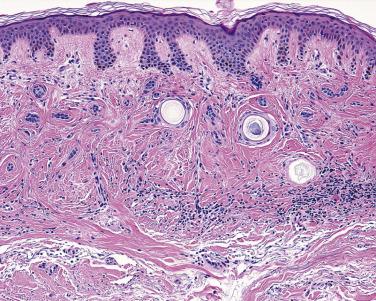
The differential diagnosis is with morpheic basal cell carcinoma, microcystic adnexal carcinoma, and metastatic carcinoma, particularly of the breast, all of which may show asymmetry, heterogeneous patterns of dermal sclerosis, and subcutaneous involvement at the time of diagnosis. The assessment of a superficial shave biopsy, however, should be evaluated with caution because such biopsies may contain areas in which one cannot differentiate between these indolent or more aggressive tumors.
Cutaneous lymphadenoma is a benign tumor of basaloid cells infiltrated by numerous lymphocytes and other mononuclear cells. Some have areas that are similar to folliculosebaceous structures. A few also have some degree of ductal differentiation.
The lesion presents most often on the face of young adults. In some cases it is possible to elicit a history of slow growth for over 20 years, supporting both its benign biologic behavior and self-limited nature. Clinically, it appears as an ill-defined, flesh-colored area of cutaneous infiltration.
Histologically, there are multiple dermal epithelial lobules, often without significant epidermal connection ( Fig. 23.67 ). The lesion has a well-developed, relatively acellular fibrous stroma with few inflammatory cells. The epithelial lobules have a distinct peripheral layer of cuboidal or flattened keratinocytes and rare whorled foci of keratinization. In the midst of these epithelial islands are large cells with large nuclei, prominent nucleoli, and ample amphophilic cytoplasm intermixed with numerous small lymphocytes ( Fig. 23.68 ). Although there appears to be a selective homing of lymphocytes within the epithelium, some spillage occurs into the stroma. Numerous intralobular dendritic cells are demonstrated by S100 protein stain. It has been argued that this type of lesion is an adamantinoid trichoblastoma. While we believe that these lesions may exhibit follicular differentiation, we eschew the term adamantinoid to refer to these lesions. We believe that these are closer in pattern to desmoplastic trichoepithelioma, but the fact that some ductal and/or sebaceous structures, as seen in our own series, are present in some lesions makes the original term cutaneous lymphadenoma appealing. The differential diagnosis includes basal cell carcinoma, which was undoubtedly the usual diagnosis for these lesions prior to the development of the concept.
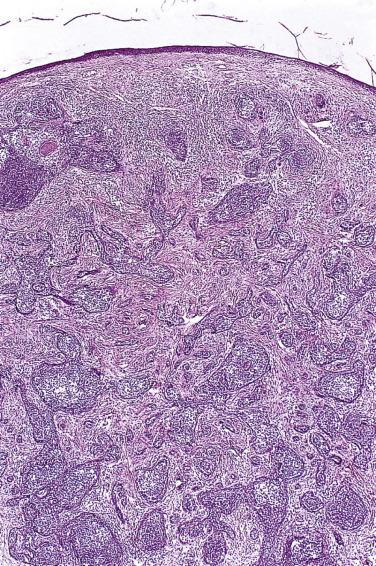
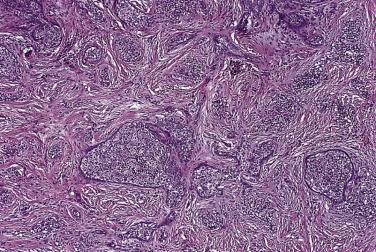
Become a Clinical Tree membership for Full access and enjoy Unlimited articles
If you are a member. Log in here